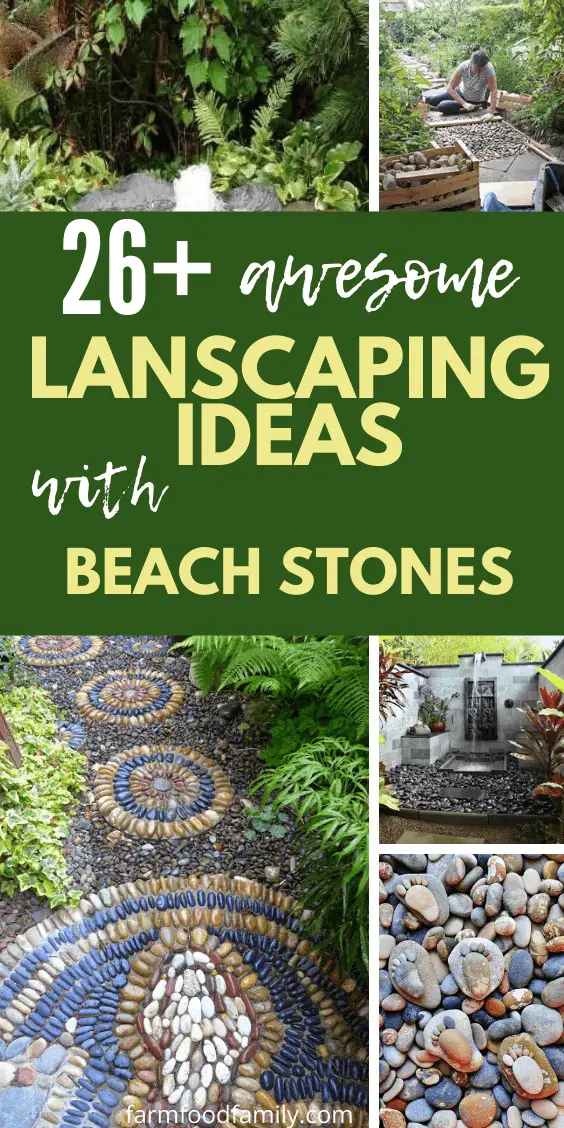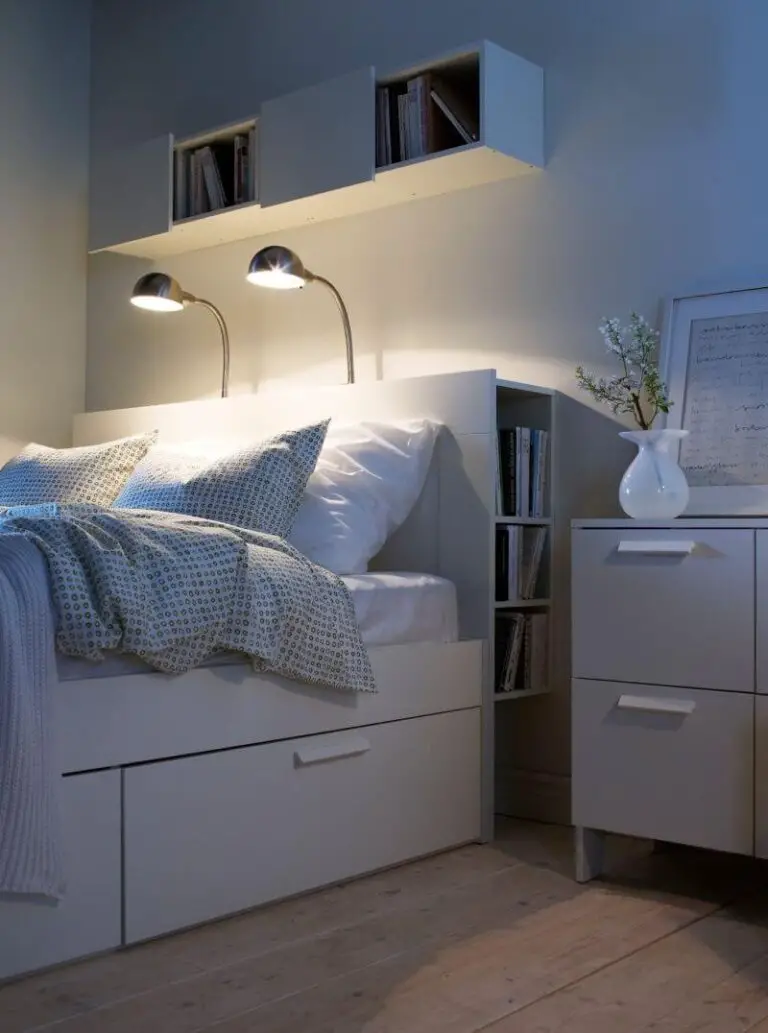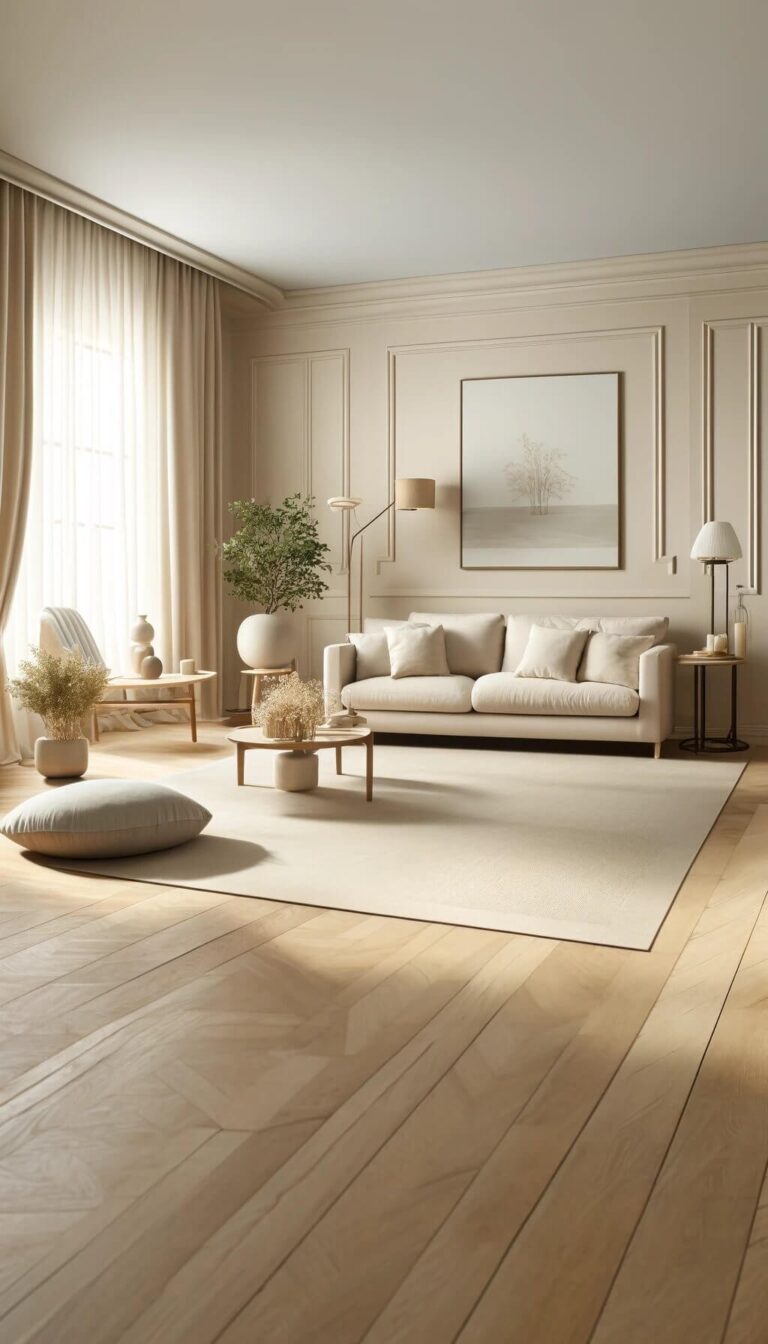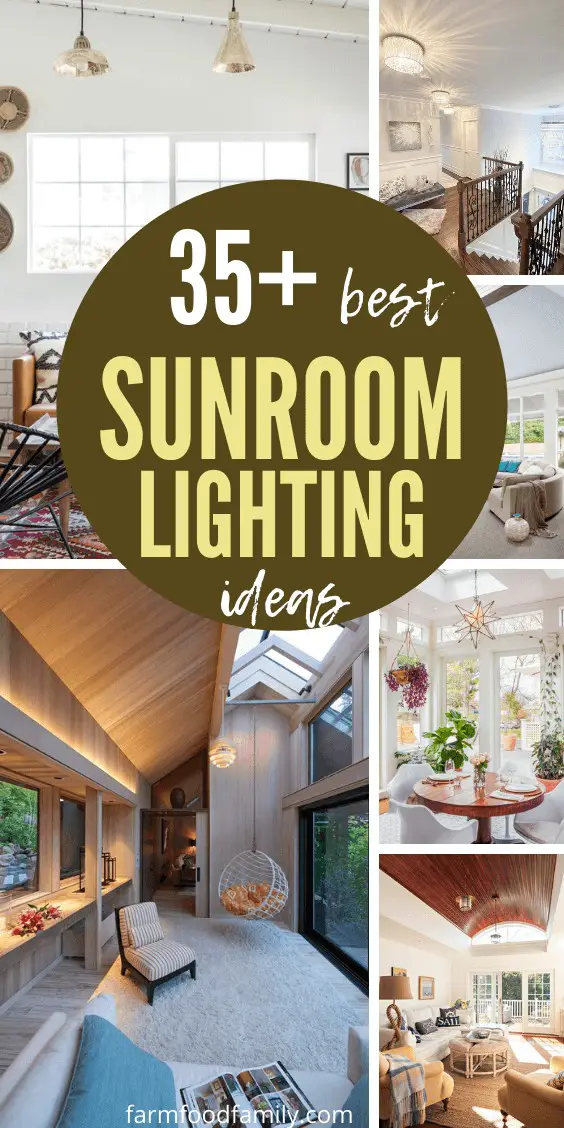55 Easy And Cheap Floating Deck Ideas For Your Backyard
A floating deck is a unique structure that stands apart from the main home, offering a distinct and separated space. Unlike traditional decks attached to the house’s foundation, floating decks can be placed directly on the ground or surrounded by various materials like gravel or wood chips. If you’re considering building a floating deck in your home, there are many inspiring ideas to explore.
In this article, we’ll delve into the essential building aspects of floating decks, as well as highlight some notable design variations and creative solutions.
What is a floating deck?
A floating deck is a self-contained structure that stands alone, earning its name due to its independence from any surrounding buildings or structures. Unlike traditional decks, these freestanding designs don’t require digging for concrete footings, nor do they necessitate the installation of ledgers or extensive side cutouts.
This liberates DIY enthusiasts and professionals alike from the labor-intensive aspects of deck construction.
As a result, you can expedite the process by skipping those time-consuming tasks, ultimately saving both labor hours and financial resources. With these advantages in mind, it’s little wonder that floating decks have gained popularity for their ease of installation and overall efficiency.
55 floating deck ideas
As we dive into the heart of this post, let’s explore some truly impressive and functional floating deck designs that can elevate your outdoor space. These inspiring ideas are categorized to provide a range of options, giving you the freedom to choose the perfect fit for your home.
Low budget floating deck ideas
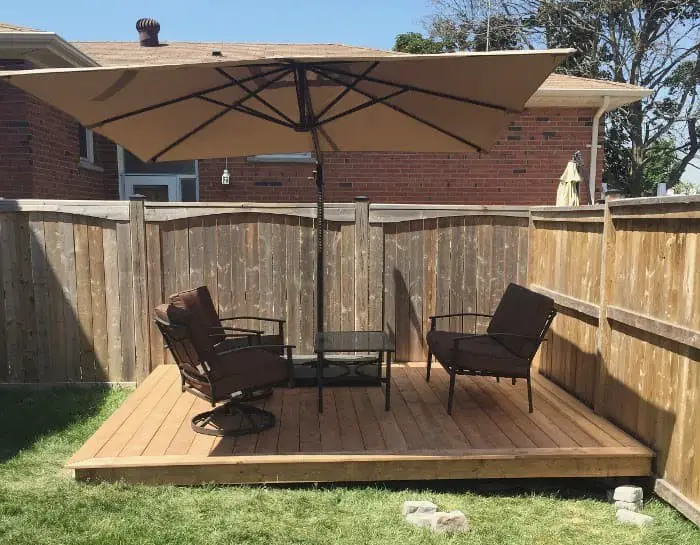
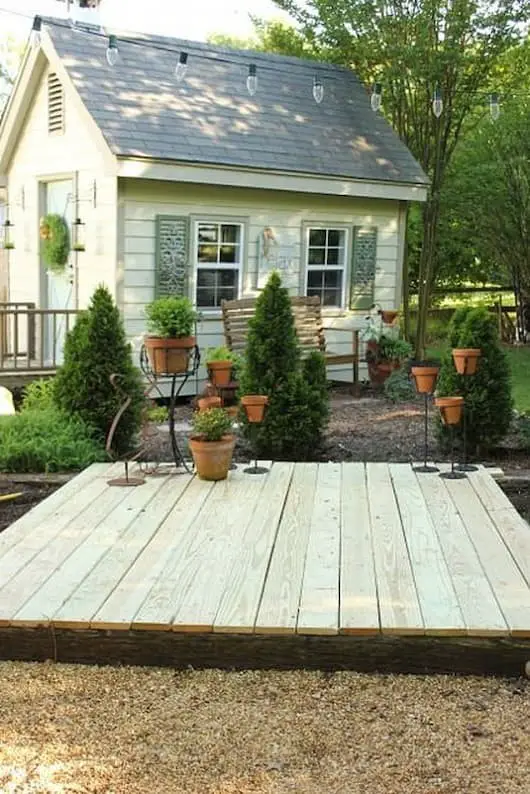
As your backyard evolves, it’s natural to want more than just a perfectly manicured lawn and standard privacy fencing to elevate its aesthetic appeal. One way to do this is by incorporating a small, floating deck that adds visual interest and functionality to the space. In one corner of the yard, a 10×10 wood deck rises 2 feet off the ground, providing a cozy gathering spot for family and friends.
A vintage seating set and coffee table are thoughtfully arranged around the deck, with a small bistro umbrella offering shade from the sun. The overall effect is charming and inviting, making it the perfect spot to relax and enjoy the great outdoors. For a more rustic take on the floating deck concept, consider repurposing railroad ties as the support structure and using reclaimed wood for the decking planks.
This adds a touch of country charm to the space, while minimalist accent pieces arranged on one side keep things simple and uncluttered. The remaining space can be left open, allowing for easy movement and the ability to add portable seating if needed.
Floating deck with pergola
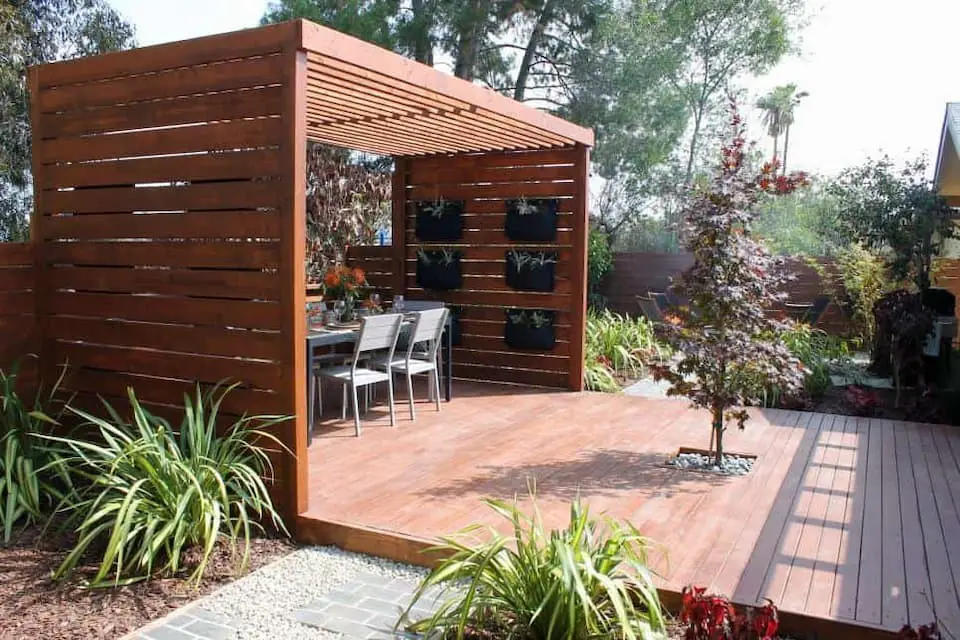
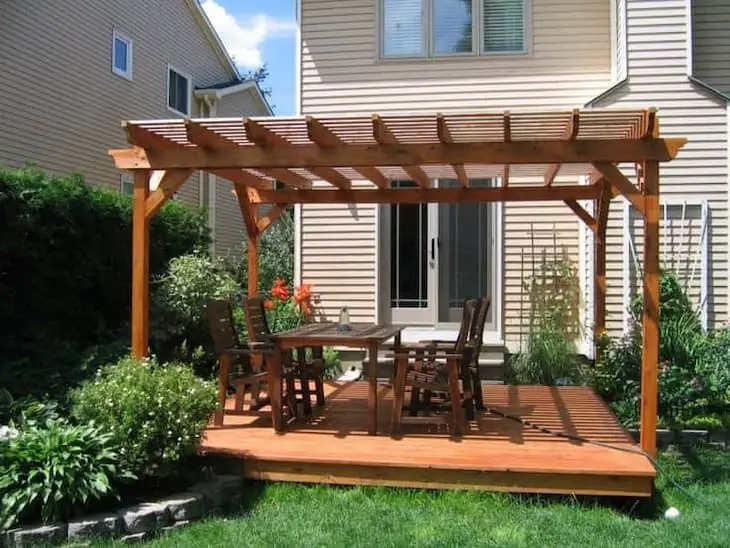
Decks and pergolas are timeless combinations, offering more than just shade. A well-designed pergola can create an intimate atmosphere perfect for social gatherings. This particular design eschews traditional wide-gapped slats, instead featuring side fencings for enhanced privacy. The result is a cozy corner ideal for people to congregate. However, those seeking a more classic look might prefer a wooden pergola with acrylic screens overhead.
The uniform aesthetic of this floating deck makes it truly exceptional, with every element working in harmony to create a phenomenal space.
Floating deck with outdoor kitchen
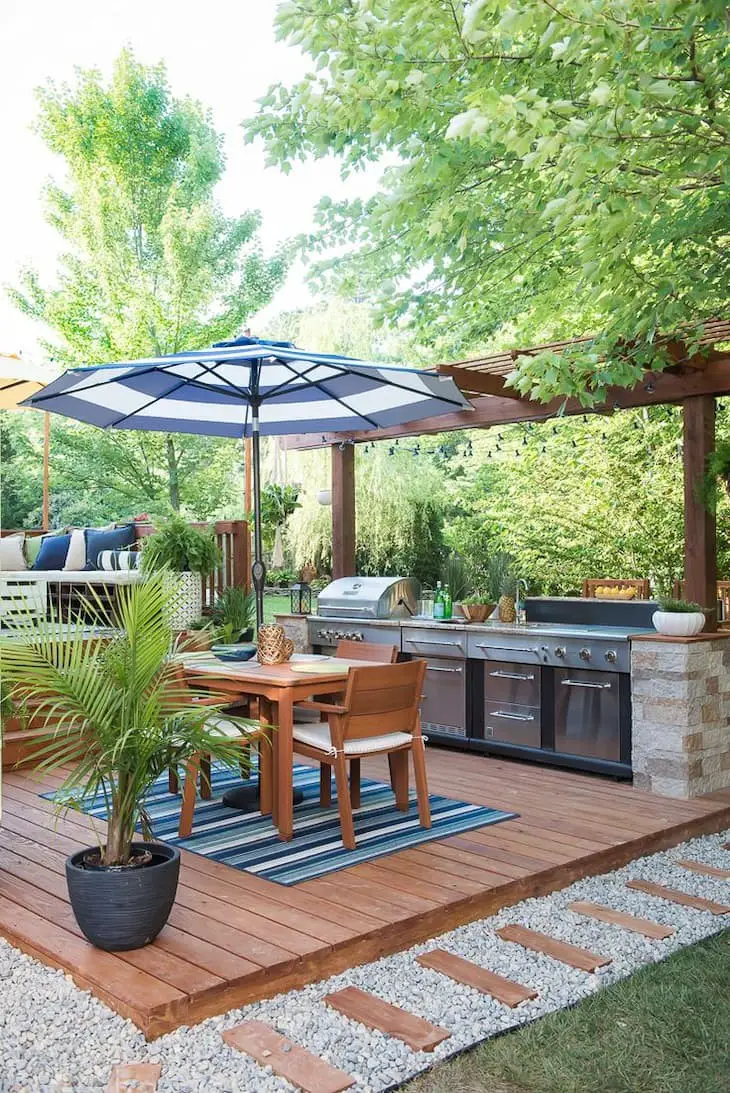
While outdoor kitchens often evoke images of grand stone constructions, they can also be more understated yet still functional and inviting. A great example of this is a floating deck made from composite materials that mimic the look of wood. This durable option not only supports heavy loads but also provides a cozy atmosphere with its elevated platform.
The compact kitchen and cook station are cleverly designed to be easily accessible, fostering an intimate sense of connection between cooking and socializing.
Floating pallet deck
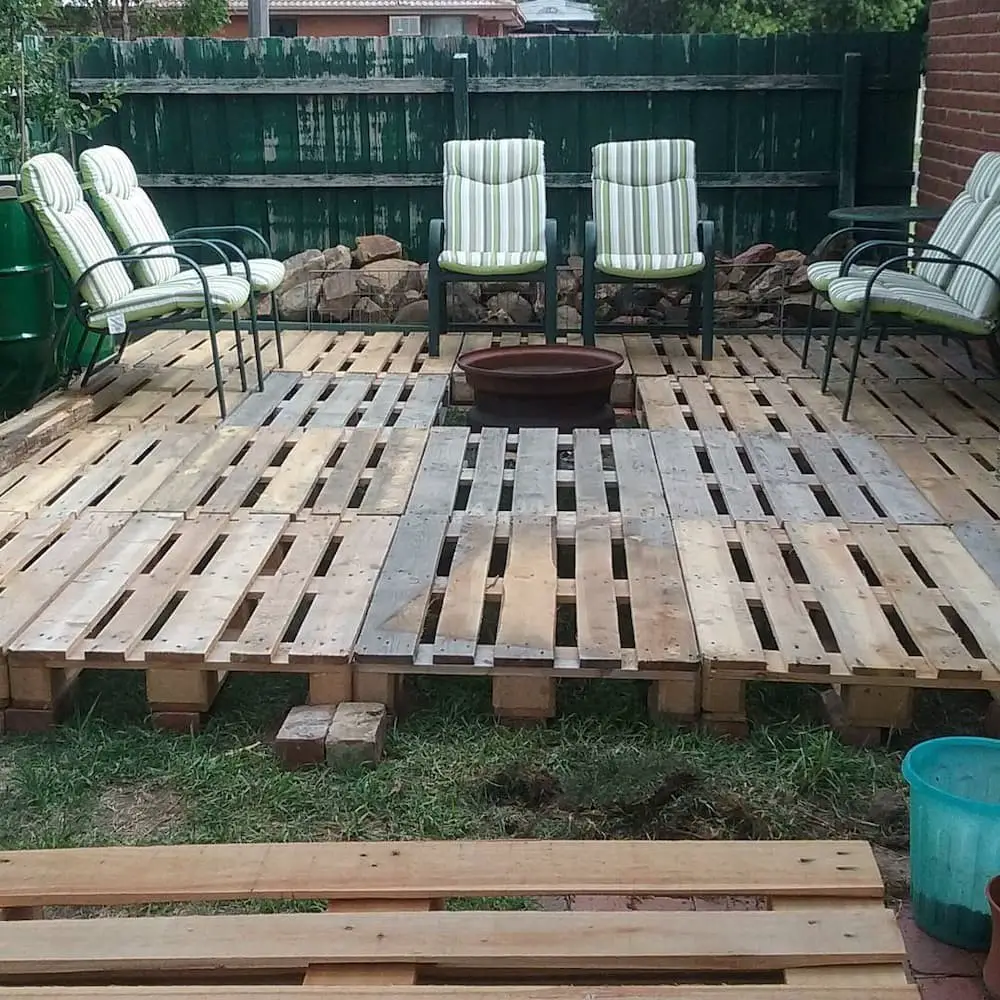
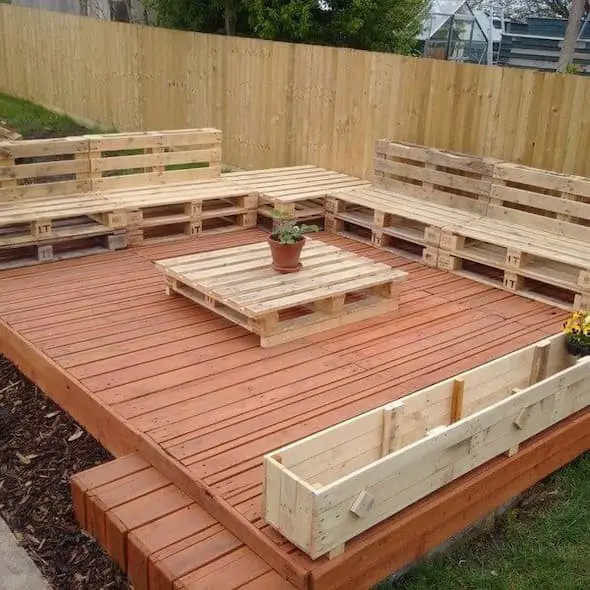
Transforming surplus wood pallets into a unique floating deck can be an exciting DIY endeavor. The space between the pallets creates a rustic, airy atmosphere, while a metal firepit adds warmth and coziness to the overall design. For added visual interest, consider painting the decking with a bold color, contrasting beautifully with the natural wood of the enclosure. The interlocking design of the pallets also lends durability to the structure.
Floating deck next to house
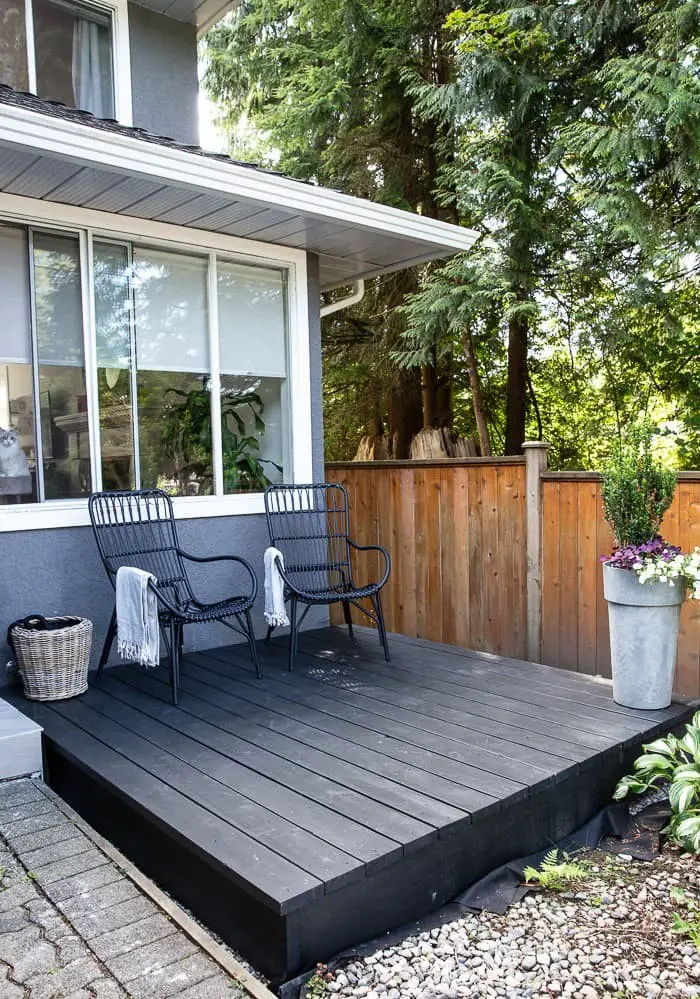
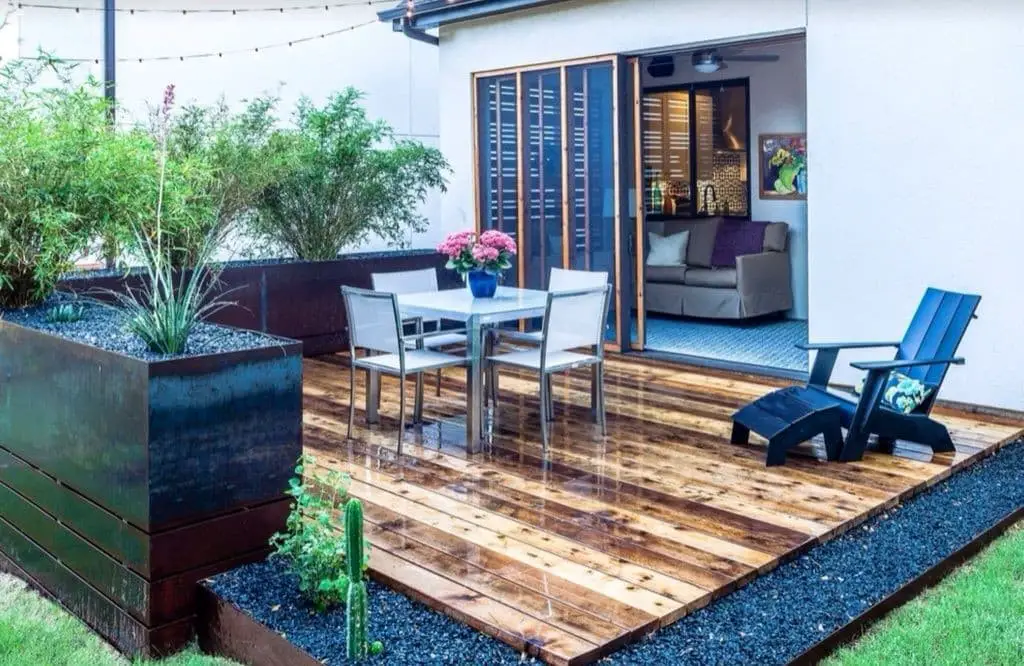
To create a harmonious transition between indoor and outdoor spaces, consider extending your back patio with a floating deck that seamlessly blends in with its surroundings. This small wooden structure, coated in a sleek black finish, serves as a perfect spot for lounging and relaxation, subtly separating itself from the main exterior aesthetic while maintaining a cohesive look. The neutral tones also complement the surrounding environment, creating a calming atmosphere.
Similarly, this living room space extends into an inviting lounging area by incorporating a small floating deck. The stained cedar wood platform provides a natural contrast to the black crushed gravel beneath, resulting in a modern and peaceful ambiance that harmonizes with the white walls of the home.
Floating deck over flat roof
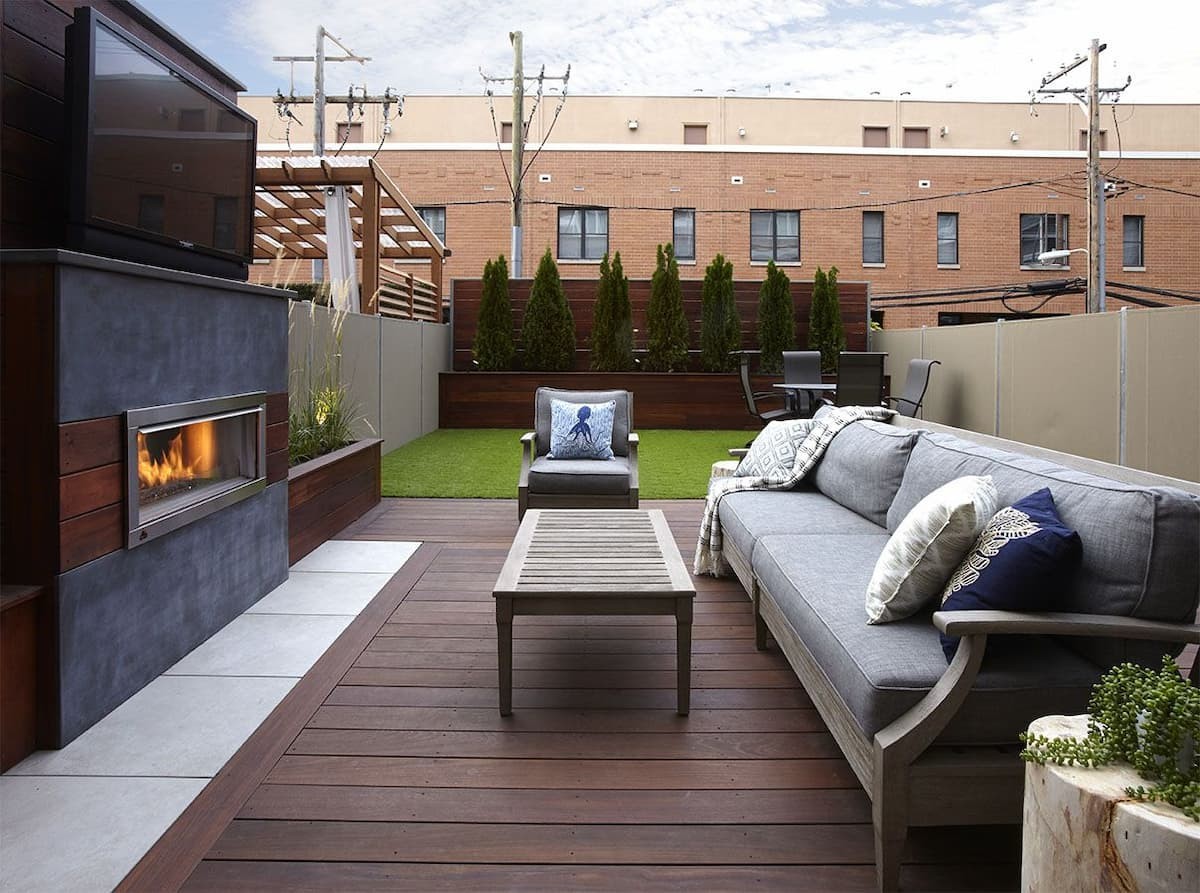
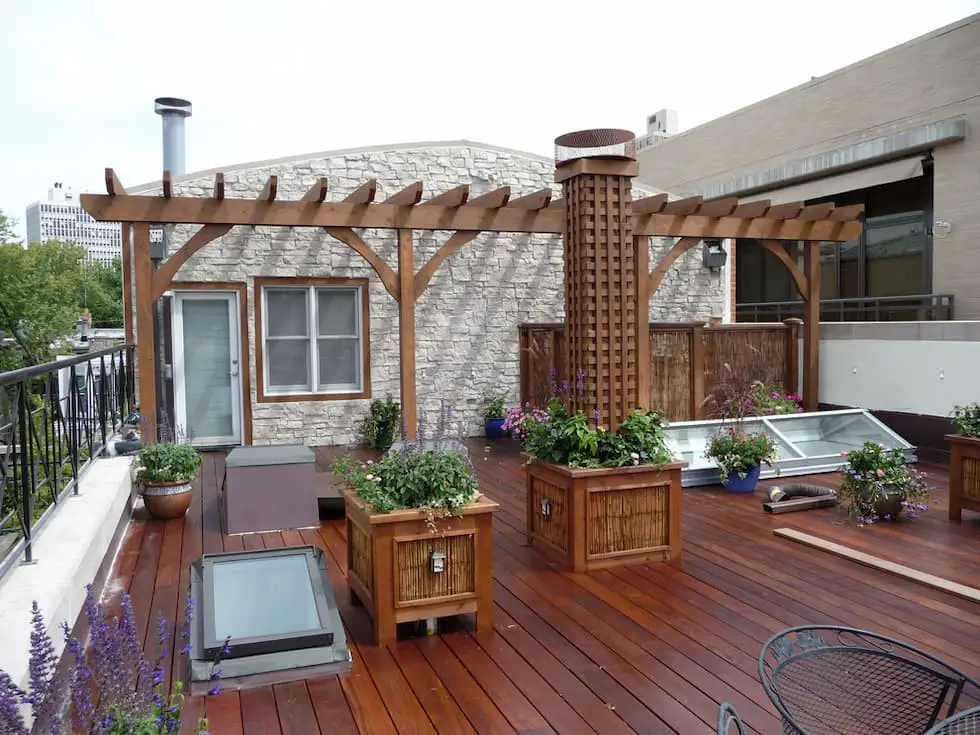
Urban high-rise homes like condominiums and penthouses often feature rooftop floating decks that seamlessly blend modern sleekness with rustic charm. This stunning example incorporates a unique combination of wood, concrete slabs, and sleek lines to create a space that exudes both elegance and warmth. The addition of a fireplace, mounted TV, and plush lounging areas further amplifies the deck’s entertainment value.
In this particular design, the existing grill and enclosure were cleverly repurposed, while the all-wood floating deck flooring and vintage-inspired pergola added a touch of classic charm. Ornate wood pieces like columns and planters took the overall aesthetic to new heights, transforming the flat roof into a serene oasis.
Floating deck over concrete slab
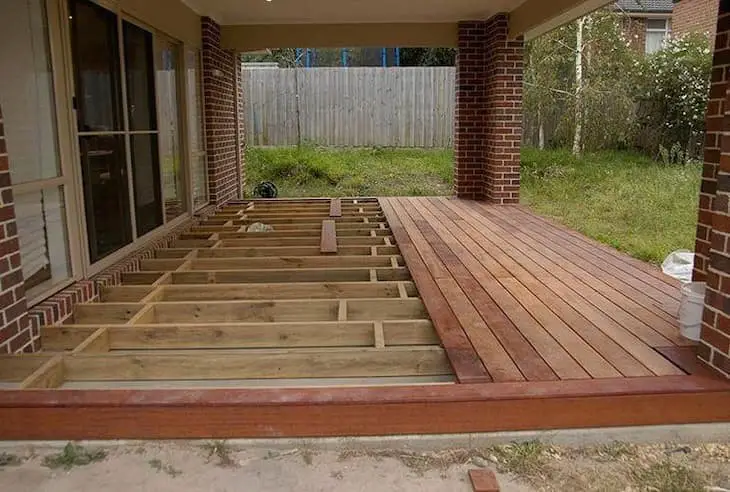
One of the best things about installing a floating deck over a concrete slab is that it’s a viable option. In fact, this method can be employed without any significant modifications to the underlying structure. A prime example of this is the wooden plank floating deck shown in the image, which serves as an expansive patio for the home. To complete the look, simply add some seating and accent pieces that harmonize with each other.
Floating deck on uneven ground
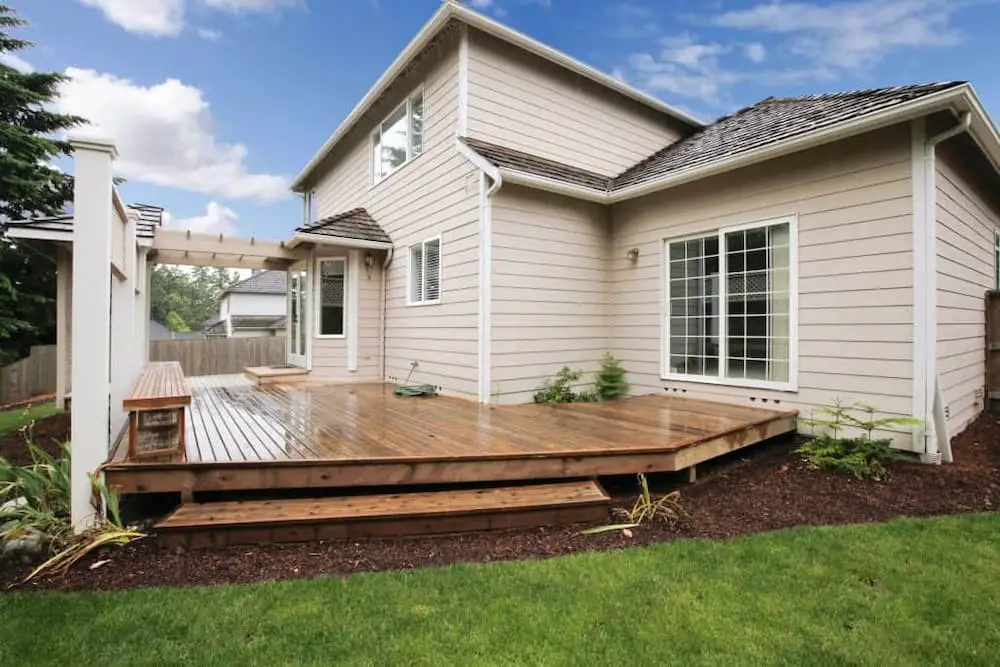
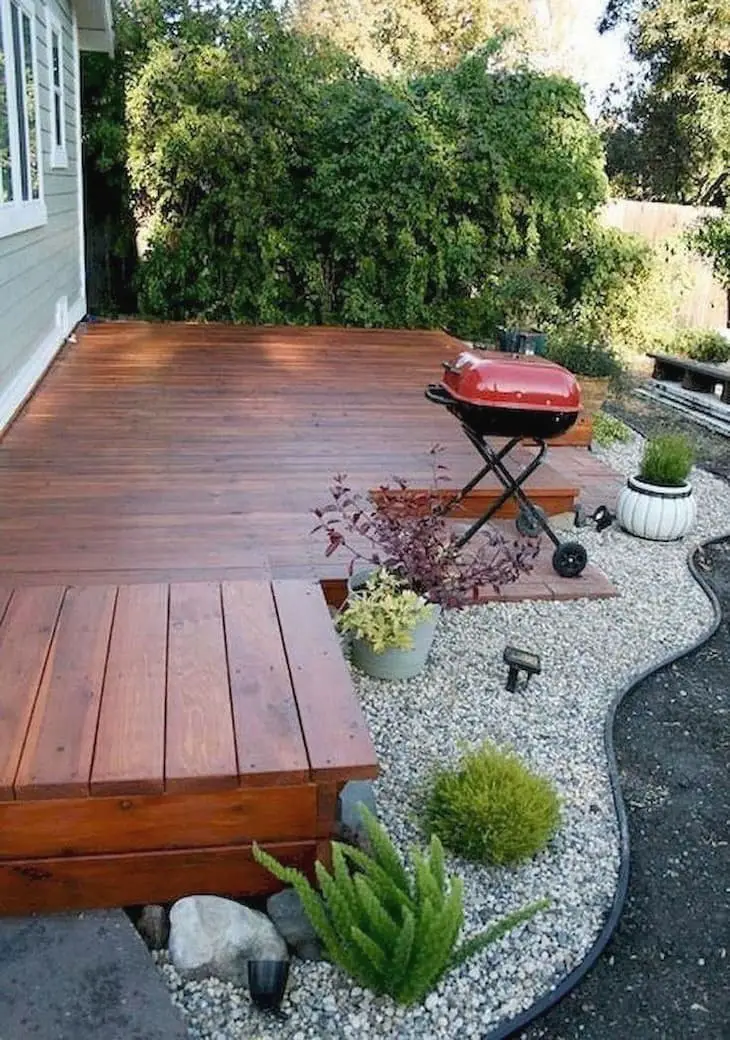
When faced with an uneven backyard, a elevated floating deck can be the perfect solution. This type of deck features stairs and additional post-to-beam braces for added support. By extending out from the home, the floating deck effectively compensates for the uneven ground. The stairs provide a balanced solution to the terrain’s irregularities, while the stained wood finish adds a touch of sophistication.
For those on a tighter budget, another option is to opt for a leveled, floating deck constructed using reclaimed wood. Simply stain it with varnish and layer it with two-tone crushed gravel for a unique and cost-effective look.
Modern floating deck
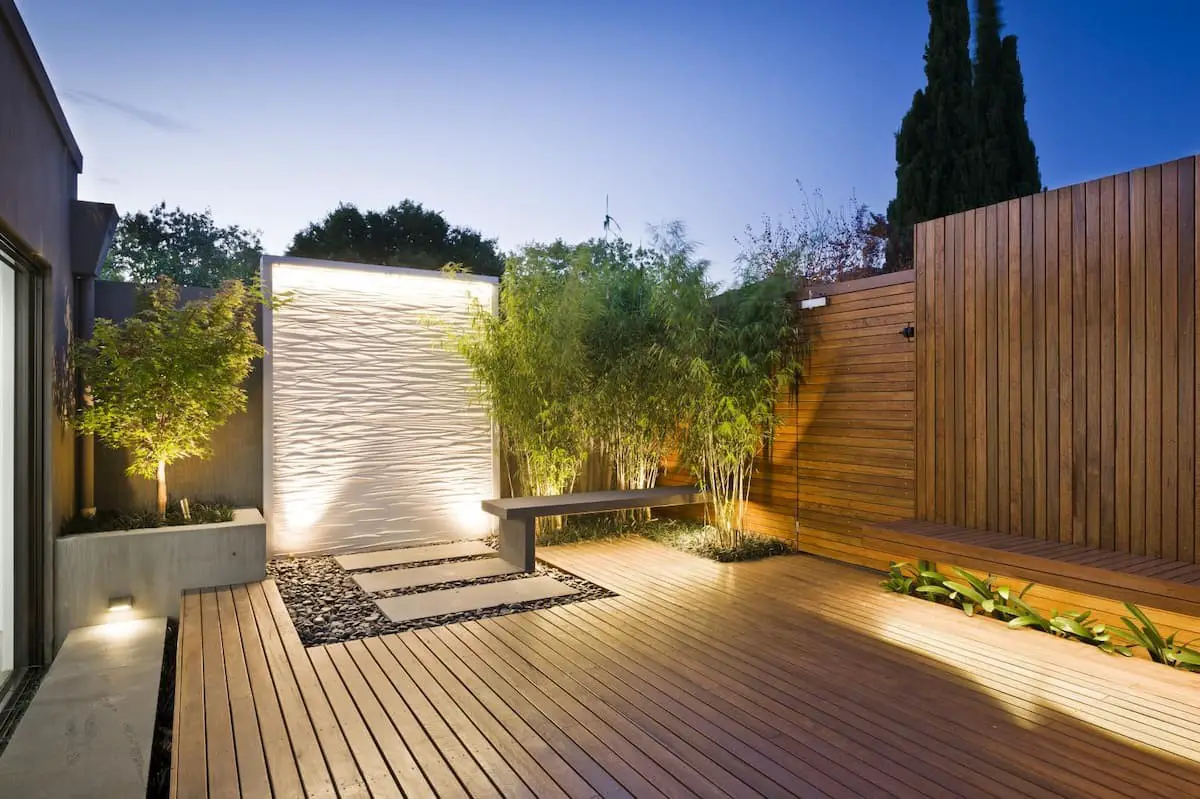
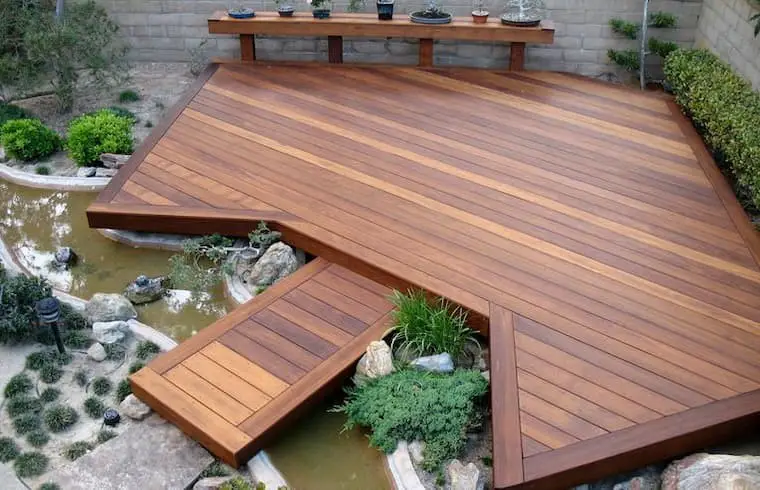
Floating decks have become a staple of modern home design, and it’s easy to see why. The clean lines and symmetrical shapes of these structures create a sense of calm and serenity, making them the perfect addition to any living space. In this design, the uniform wood planks used for both the fence and flooring create a cozy opulence that’s hard to resist.
The concrete and stone details in one corner, including the planters, seamlessly integrate with the home’s modern exterior, creating a cohesive look that’s truly stunning. But modern floating decks aren’t just about symmetry – they’re also a great way to add some visual interest to your outdoor space. Asymmetrical and geometric shapes can add a touch of whimsy and personality to an otherwise plain area.
Take this spade-shaped floating deck, for example, which stretches out into a lifeless landscape like a work of art. The contrast between the simple concrete fencing and the unique shape of the deck creates an unparalleled look that’s sure to anchor your outdoor aesthetics anytime.
Floating deck on water
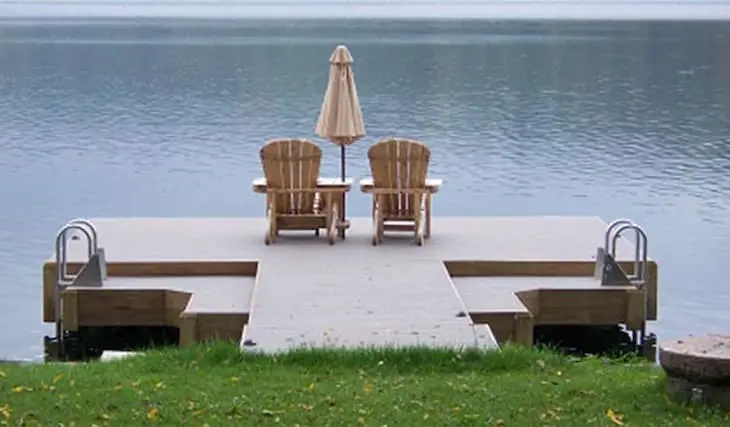
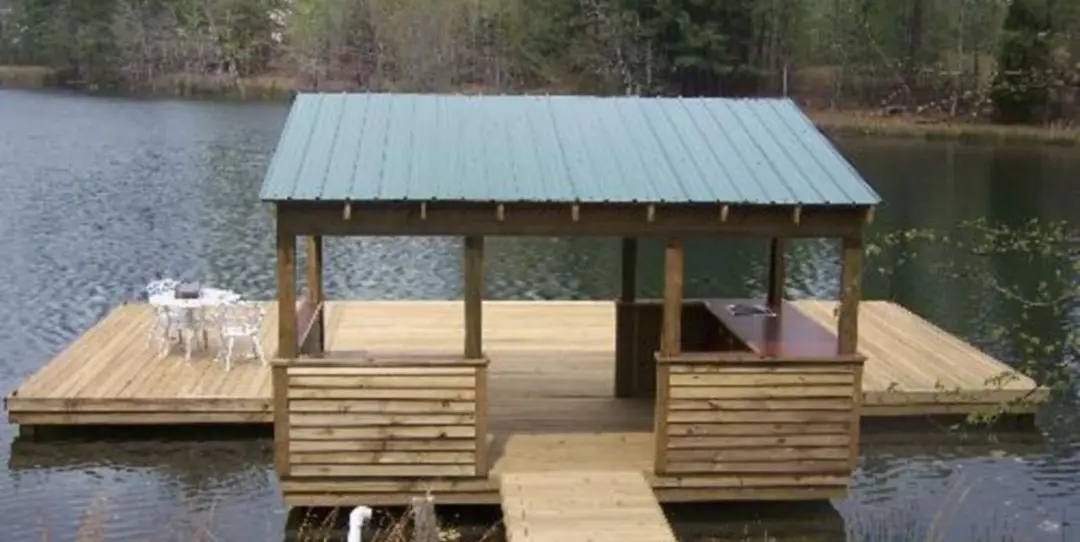
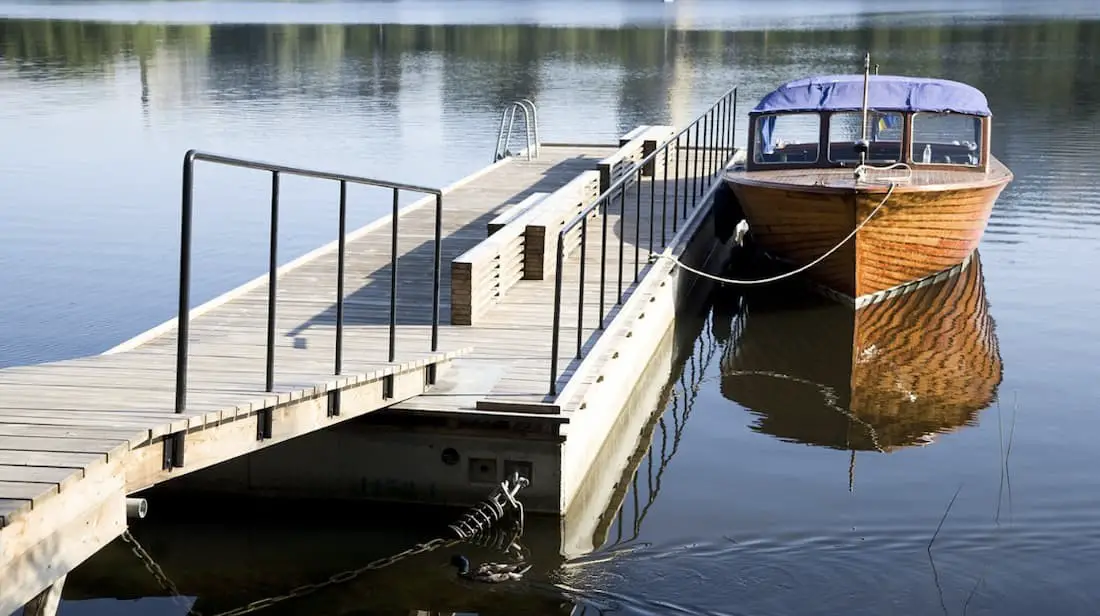
Imagine sipping beer with friends while taking in the breathtaking views of a lake or sea. The idea of unlimited chatting and soaking up the scenery is undoubtedly appealing. If you’re considering a floating deck, take inspiration from this unique concrete design featuring an irregular shape that exudes a coastal vibe thanks to the wood lounge chairs and beach umbrella. Alternatively, opt for a more traditional look with a wooden deck enclosure reminiscent of a lake house.
This setup provides ample space for lounging while also offering a cozy retreat in case of inclement weather or when you need a place to stash food and belongings.
For a truly unique floating deck experience, draw inspiration from this lake house-inspired design featuring a bent-look deck flooring that adds an extra layer of visual interest. The railing allows for unobstructed views of the lake or a steady spot to hang out by the yacht.
Floating pool deck
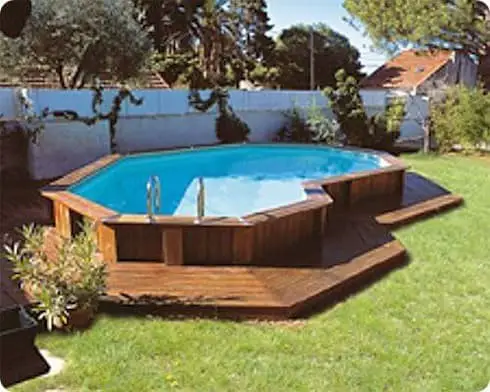
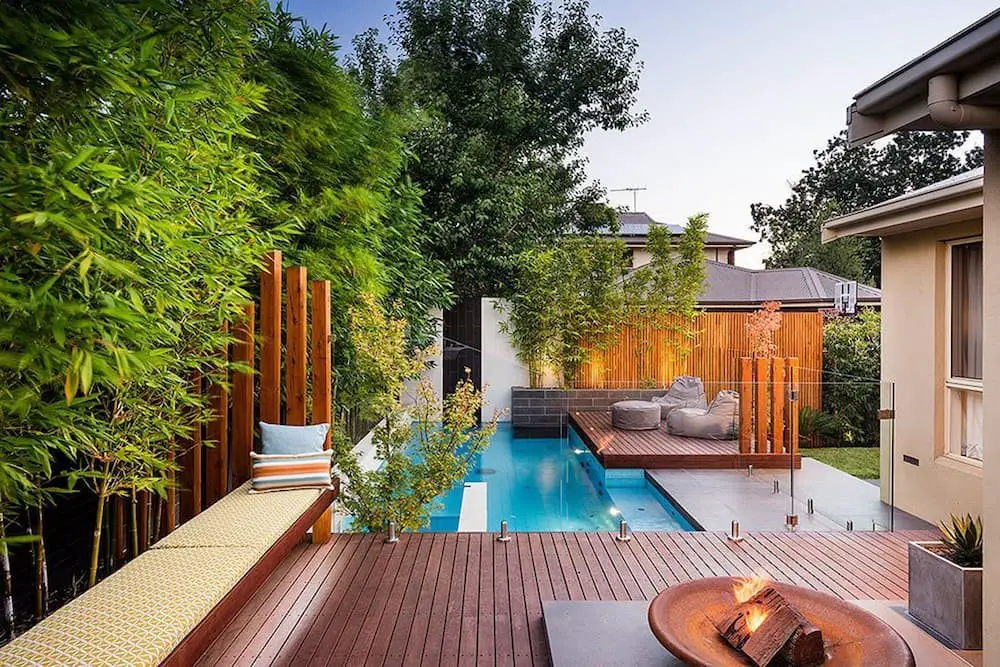
A floating pool deck that’s both crafty and luxurious is more than just a clever concept – it’s an invitation to indulge in the ultimate backyard retreat. This above-ground pool design makes use of a wooden platform with minimal elevation, allowing for greater weight capacity and accommodating a large number of people at once.
For those looking to splurge on their outdoor oasis, consider building two separate floating decks that cater to different experiences.
One deck can be situated directly by the pool, supported by a submerged concrete foundation, while the other can be elevated to offer an unobstructed view of the pool area and feature a cozy fire pit at its center.
Floating deck over septic tank
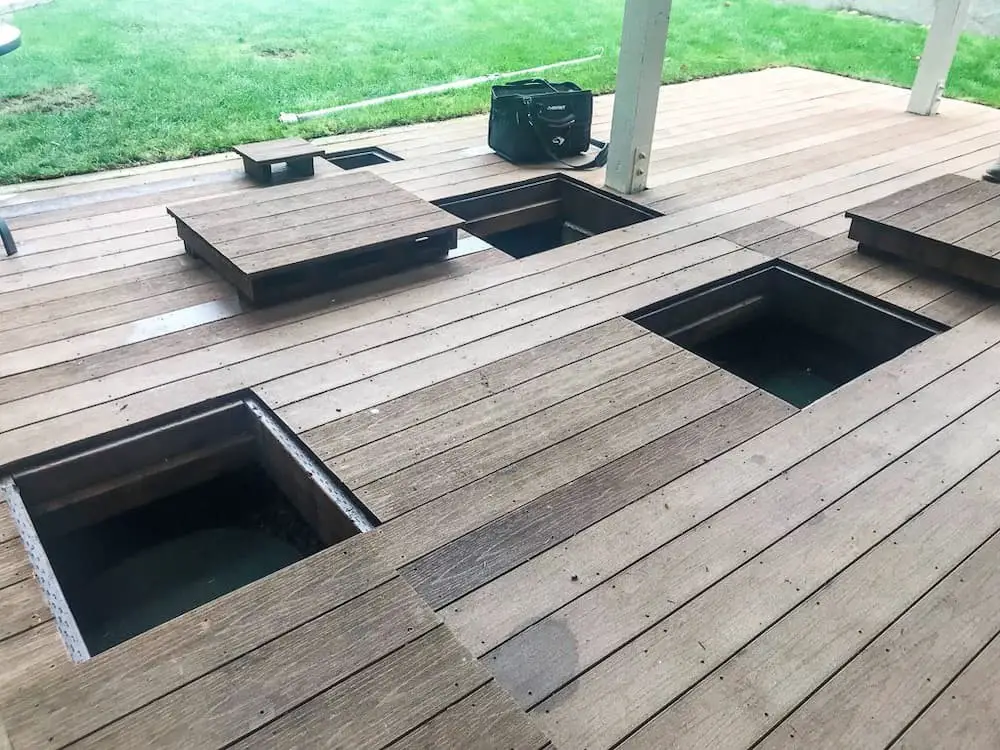
Innovative floating decks offer a clever solution for hiding unsightly features while maintaining a low-profile design. This approach features a floating deck extending from the patio, which incorporates detachable wood planks to conceal septic tank units surrounding a large home. The planks can be easily lifted during annual inspections, ensuring seamless integration with the surrounding material and minimizing visual impact.
As a result, the septic tanks are discreetly camouflaged, blending in with the overall aesthetic.
Floating deck no digging
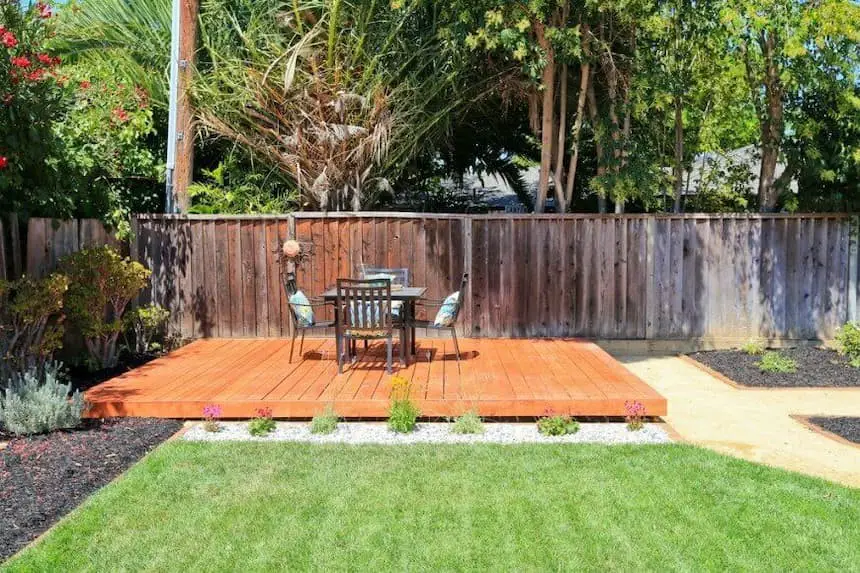
One of the most significant advantages of a floating deck is the absence of digging required for installation, as we’ve previously mentioned. This particular example features a 2-foot floating deck with a wooden framework directly connected to concrete blocks. The wood planks are carefully laid to complete the frame and then positioned atop the concrete blocks, eliminating the need for costly excavation.
Floating deck around a tree
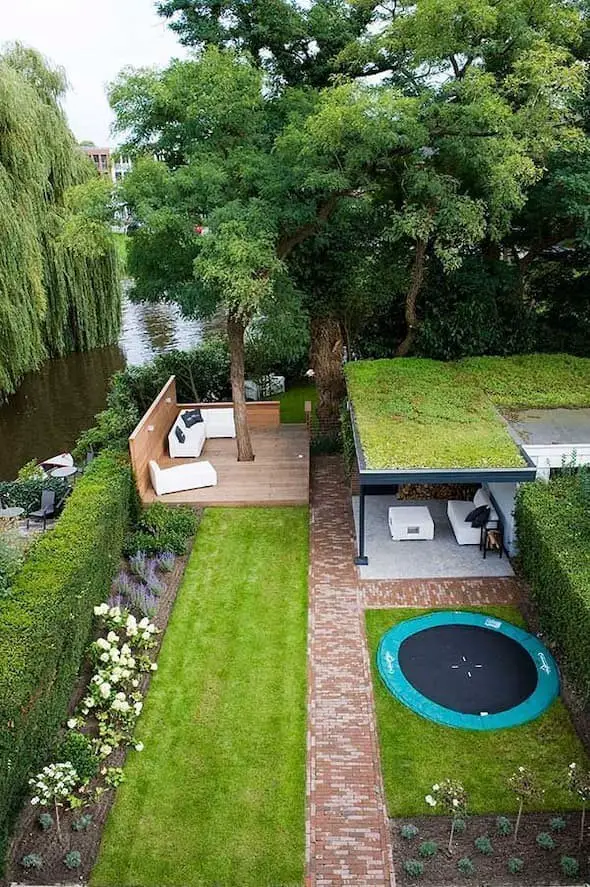

In some European countryside settings, building a floating deck around a tree is an unconventional yet charming practice. This unique feature can be seen in this German home where the tree serves as the central focal point. The surrounding tranquil atmosphere, combined with the soothing sounds of a nearby stream and lush greenery, creates a serene ambiance perfect for relaxation.
To take your outdoor living to the next level, consider constructing a more elevated floating deck in your own large backyard. Not only does this design provide an open seating area, but it also allows you to regulate the growth of nearby tree bunches while simultaneously enjoying natural shade from their branches.
Floating deck in middle of yard
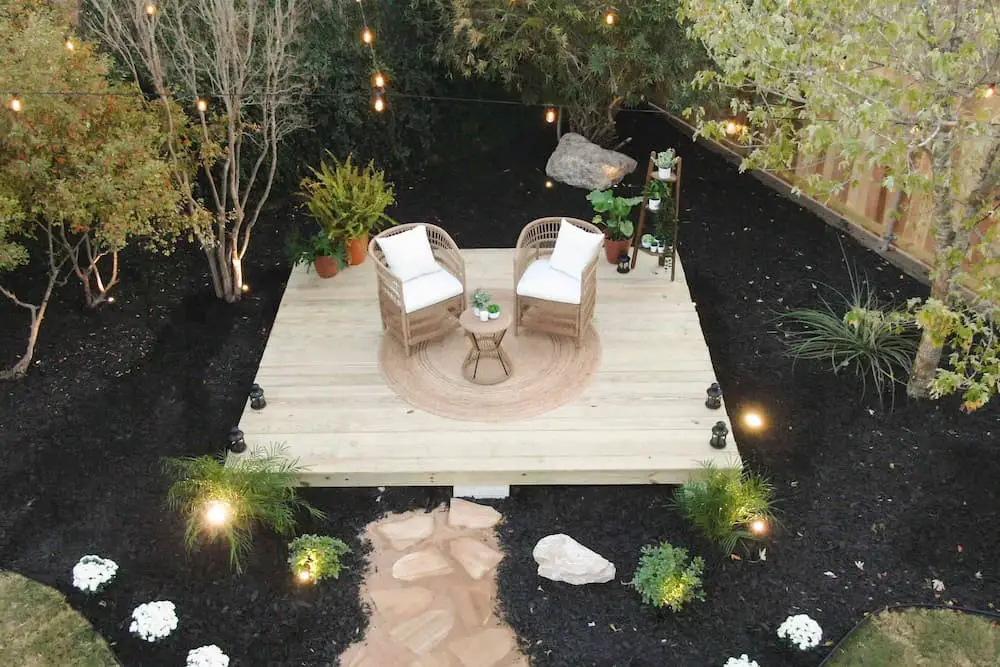
Transforming your yard into an idyllic retreat is a mere step away with the enchanting floating deck design. The combination of black soil, lush greens, and wooden fencing creates a rustic charm that effortlessly complements any suburban home. As night falls, the subtle glow of string lights suspended from trees adds a whimsical touch, making this setup an ideal blend of functionality and ambiance.
Modular floating deck
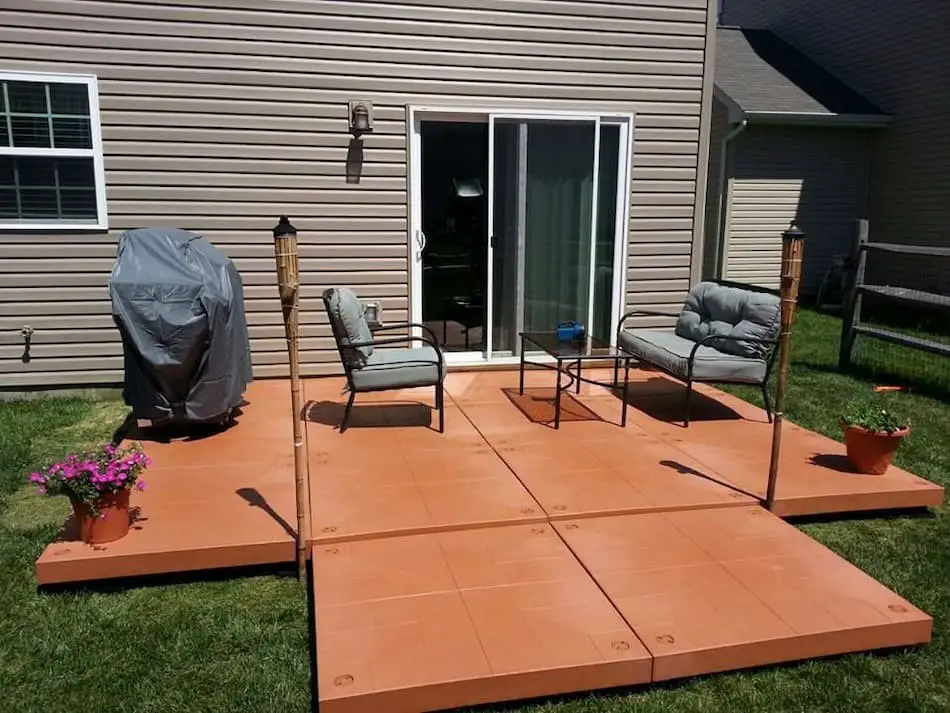
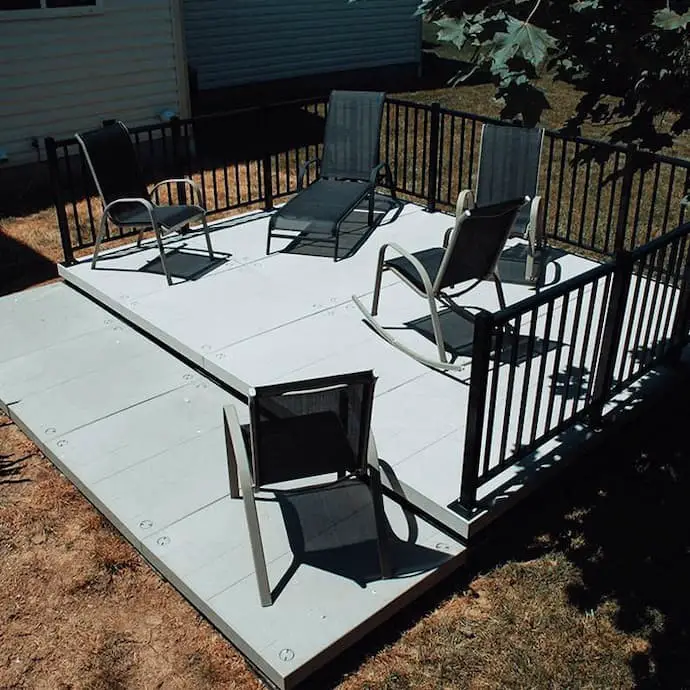
For those who aren’t comfortable with DIY projects, installing a floating deck can be simplified by purchasing modular deck kits. These kits are sold in panel form, allowing you to control the number of panels you need to cover the desired area for your floating deck. Modular decks made from composite aggregates, such as the one featured here, provide a patio extension and can be enhanced with decorative elements like tiki flames for a playful touch.
According to UDecx, these kits offer a convenient solution for creating a floating deck. Alternatively, if you prefer a more enclosed look, modular decks in gray can be paired with metal railings to create a half-enclosed space that’s perfect for lounging. Despite its simplicity, this design can actually create a cozy nook for relaxation.
Floating deck over pavers
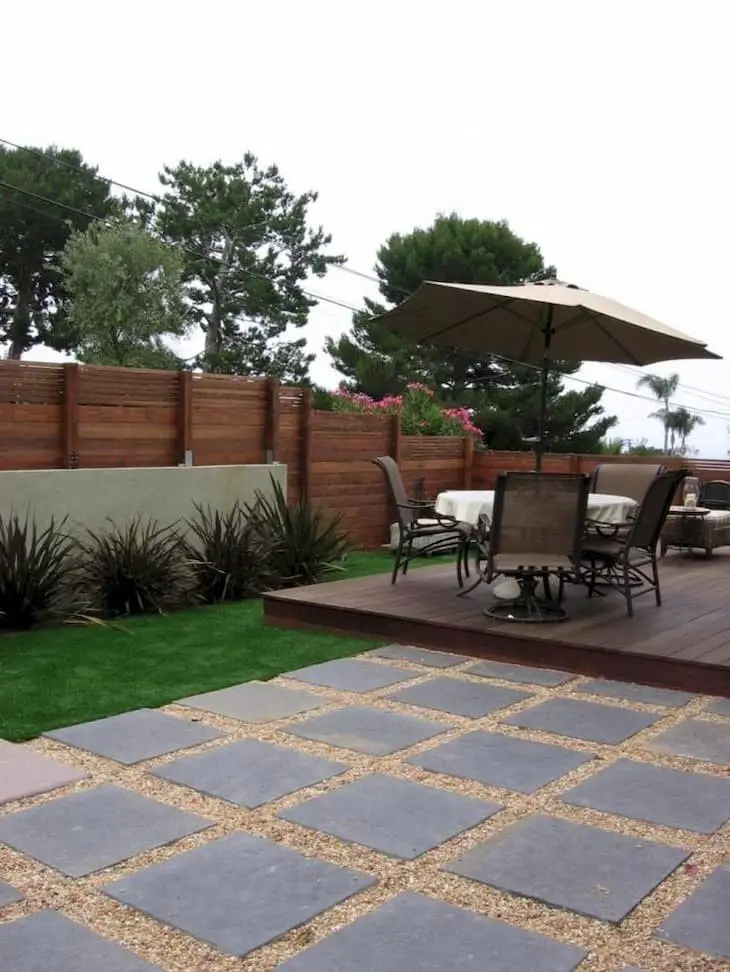
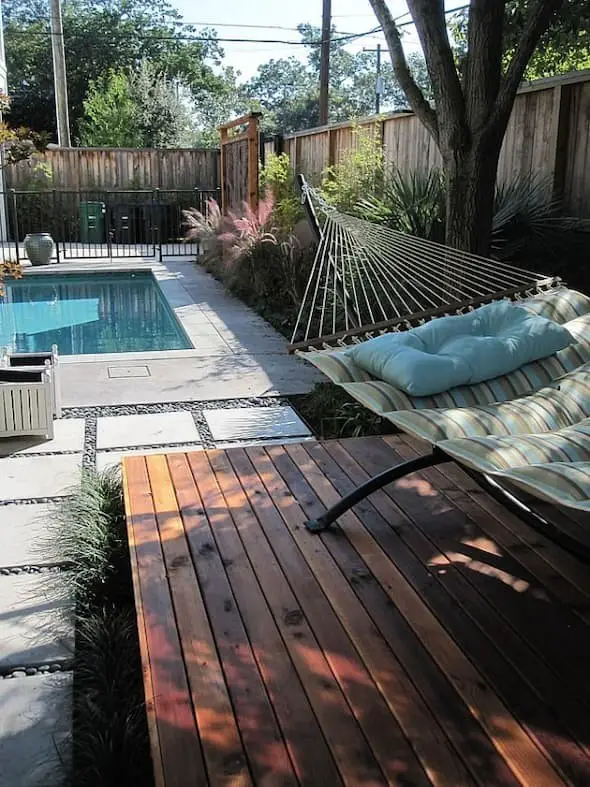
Similar to installing floating decks directly onto concrete slabs, the process for building them over pavers remains largely the same. This can be seen in the example presented, where a raised floating deck is situated between two lines of paver walkways, effectively dividing the yard into distinct areas. The harmonious contrast between the wood decking and pavers, coupled with the decorative crushed gravel pathway, adds to the overall aesthetic appeal.
This design concept can be replicated poolside, creating an inviting atmosphere perfect for relaxation. The addition of shade-providing elements, such as a hammock, suggests that this floating deck is designed for leisure activities like reading, napping, or simply soaking up the natural ambiance of the surroundings.
Floating deck with privacy wall
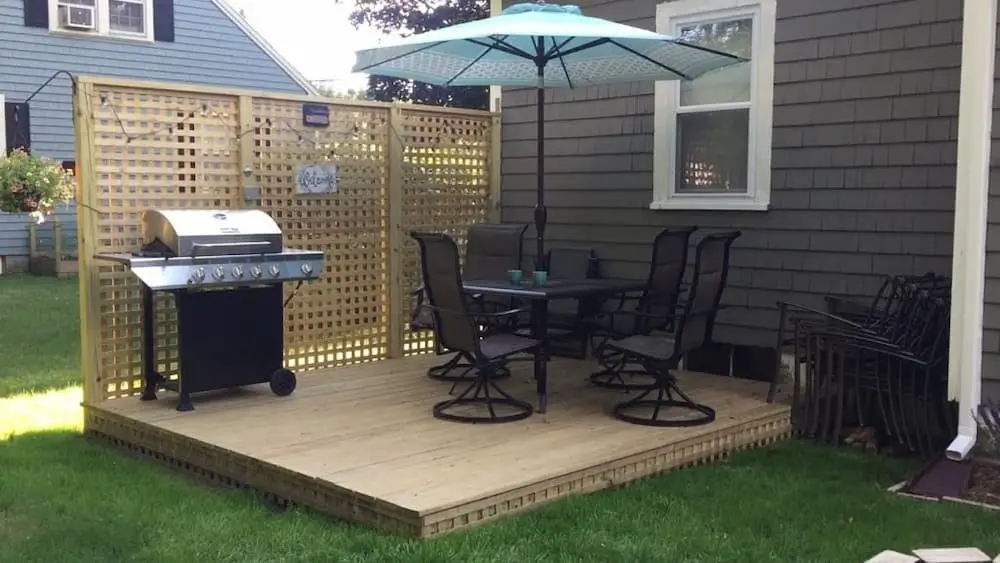
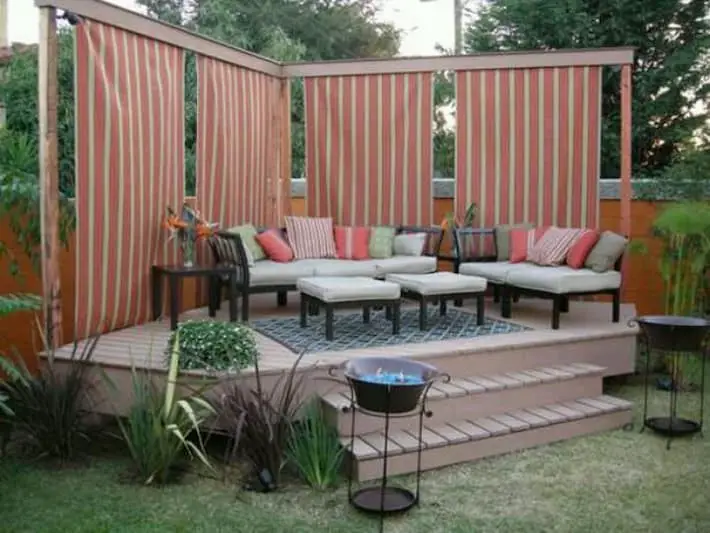
While traditional privacy walls may come to mind when thinking of enclosing outdoor spaces, modern options have expanded to include partial enclosures that balance seclusion with openness. This floating deck’s simplicity is elevated by its use of reclaimed wood for the deck, harmonizing perfectly with a matching lattice privacy wall that creates an intimate atmosphere ideal for cozy gatherings and outdoor cooking.
For a budget-friendly alternative, fabric sails installed within a basic wooden overhang can transform this floating deck into a showstopper. The addition of a small open firepit in one corner, chic seating, and an outdoor rug surrounding the deck brings to mind the iconic Coachella vibe, now accessible in the comfort of your own backyard.
Stadstuin floating deck

Wooden pallet deck
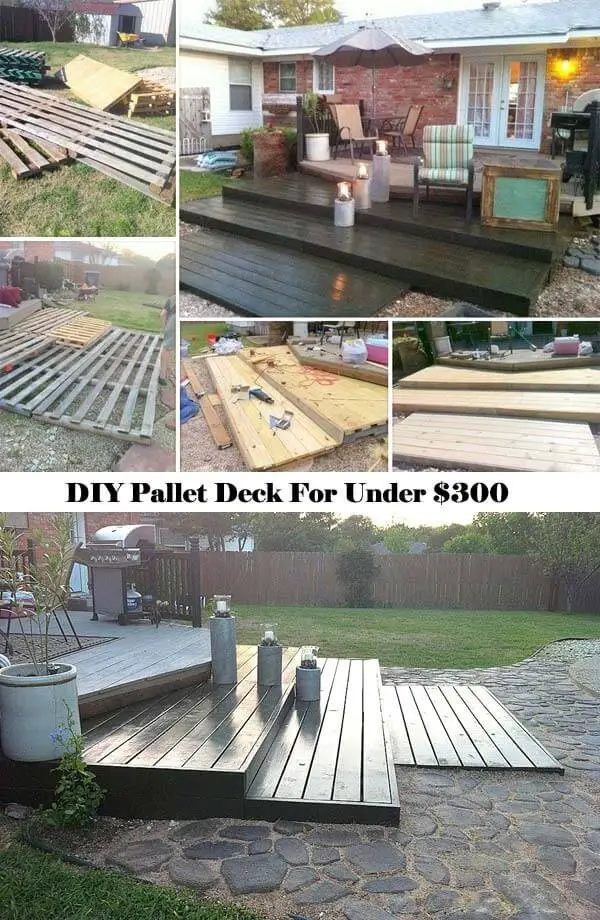
Fabulous DIY Floating Deck
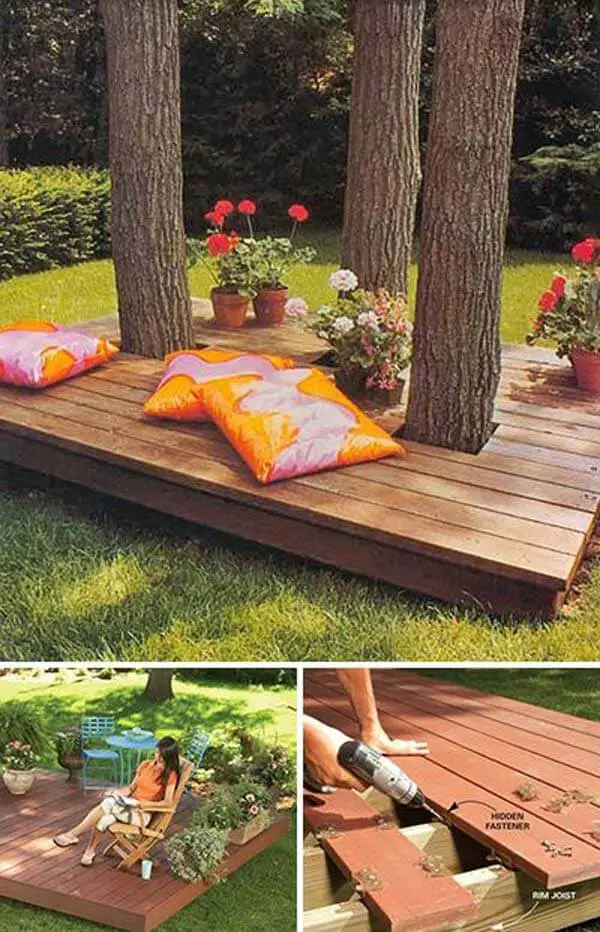
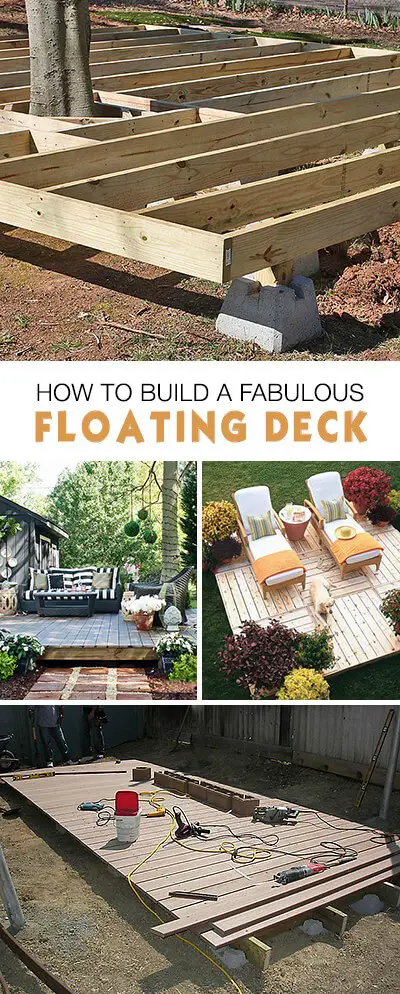
How to Build an Octagonal Deck

Transportable pontoon raft out of old pallets
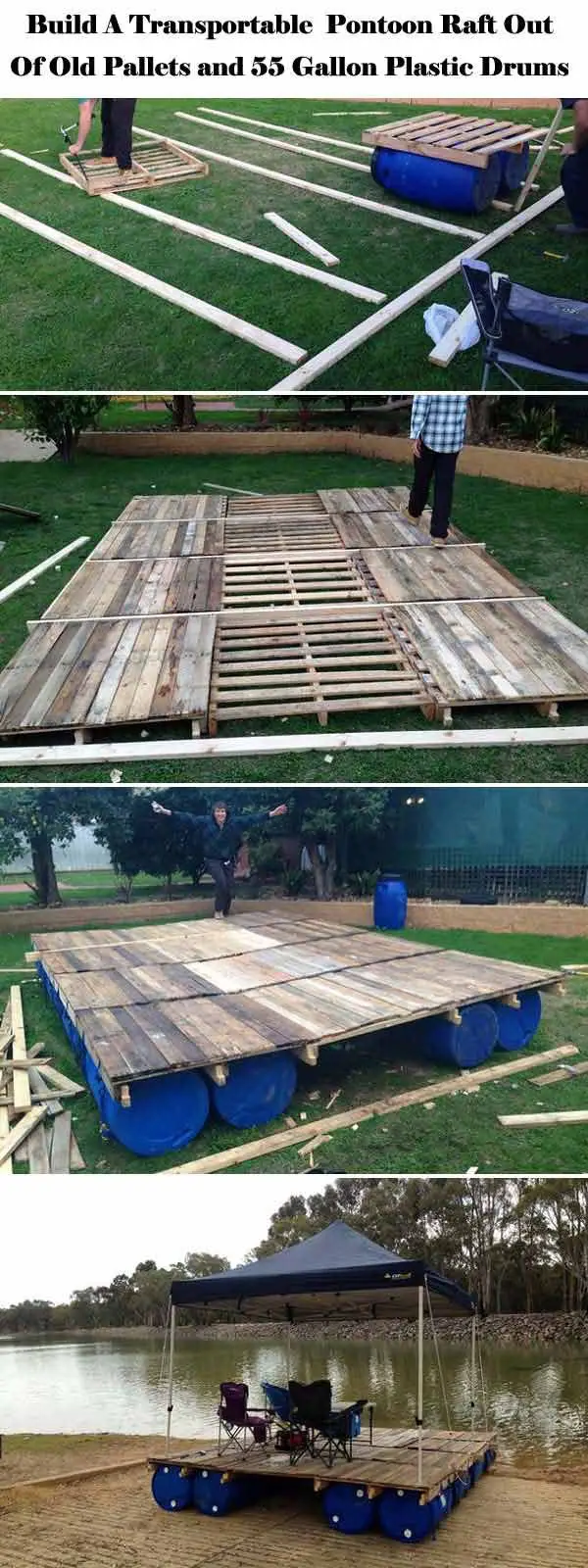
Plastic pool with wooden deck
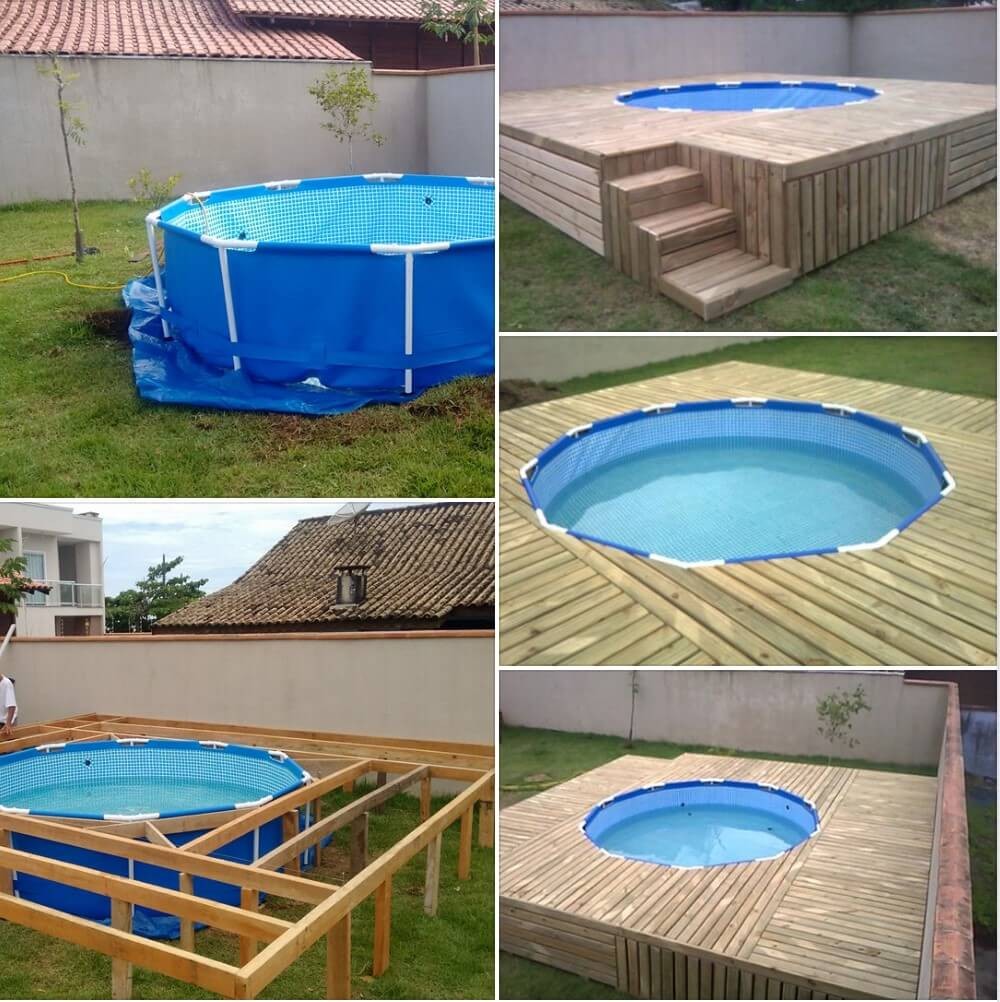
Pallet wood front porch
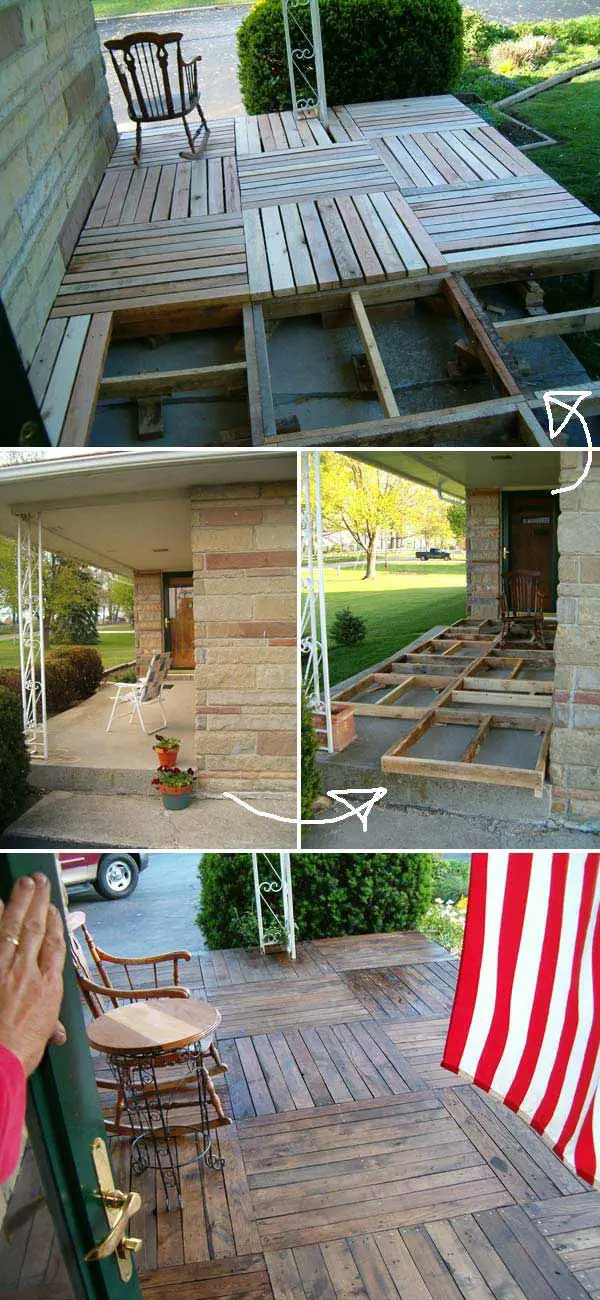
Affordable garden deck
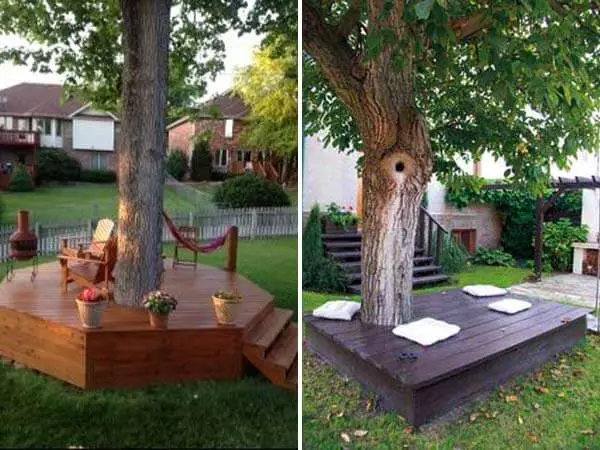
DIY Pallet Deck
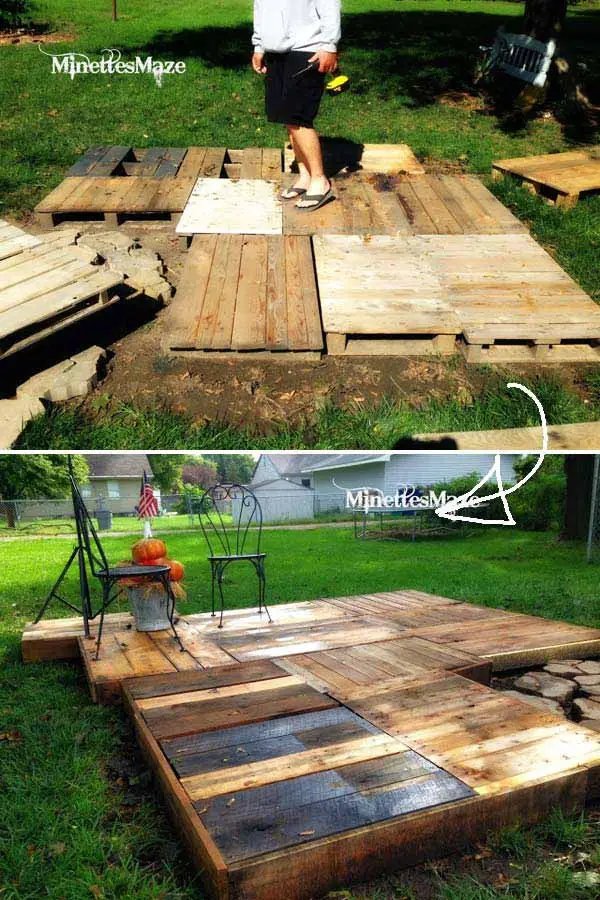
A colorful backyard patio with a new deck
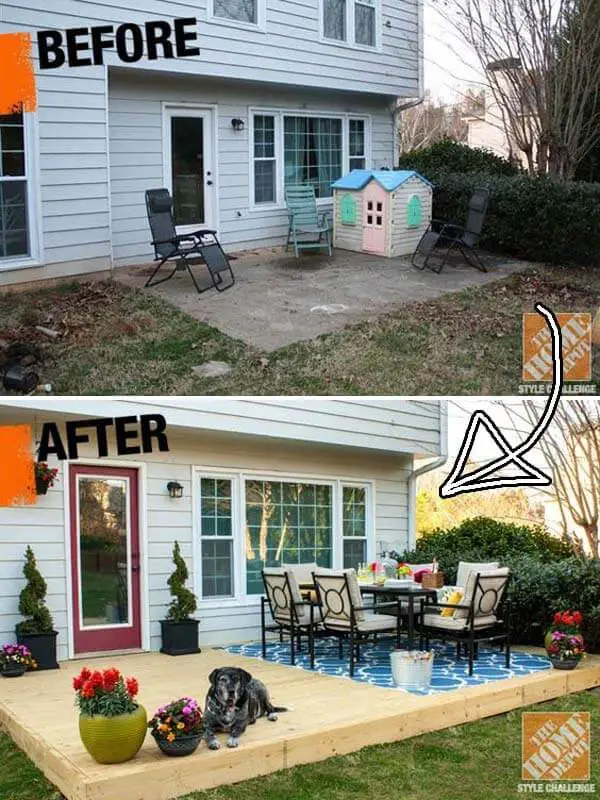
DIY Pallet Sofa
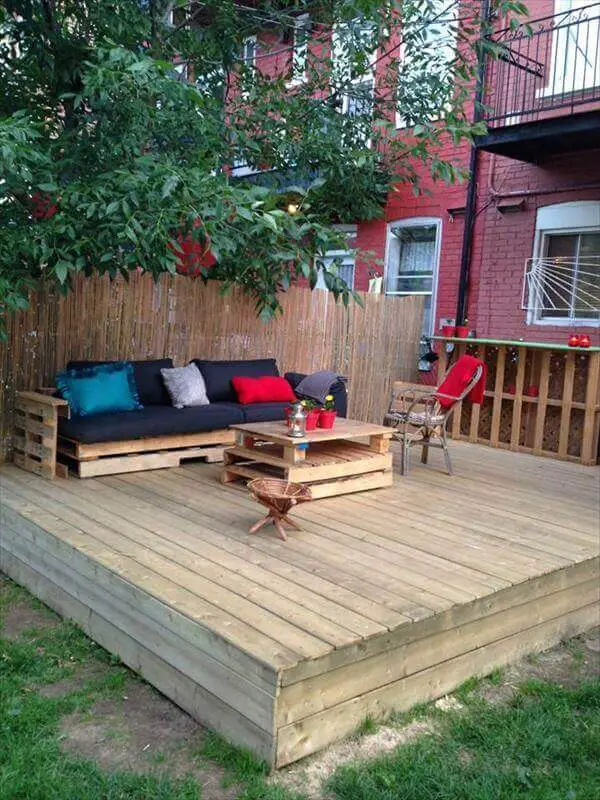
Floating deck
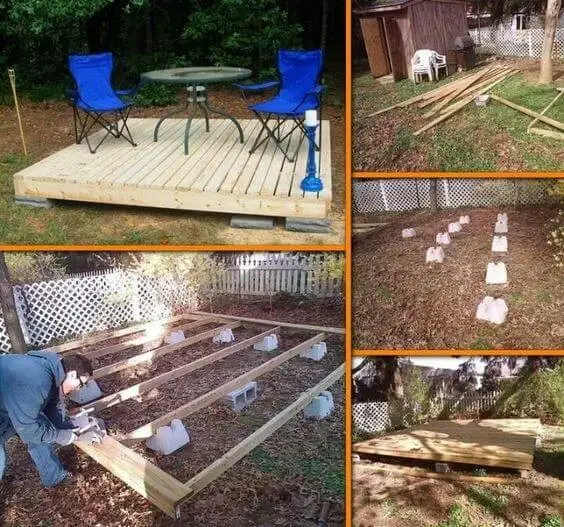
A Tree-Encompassing Deck
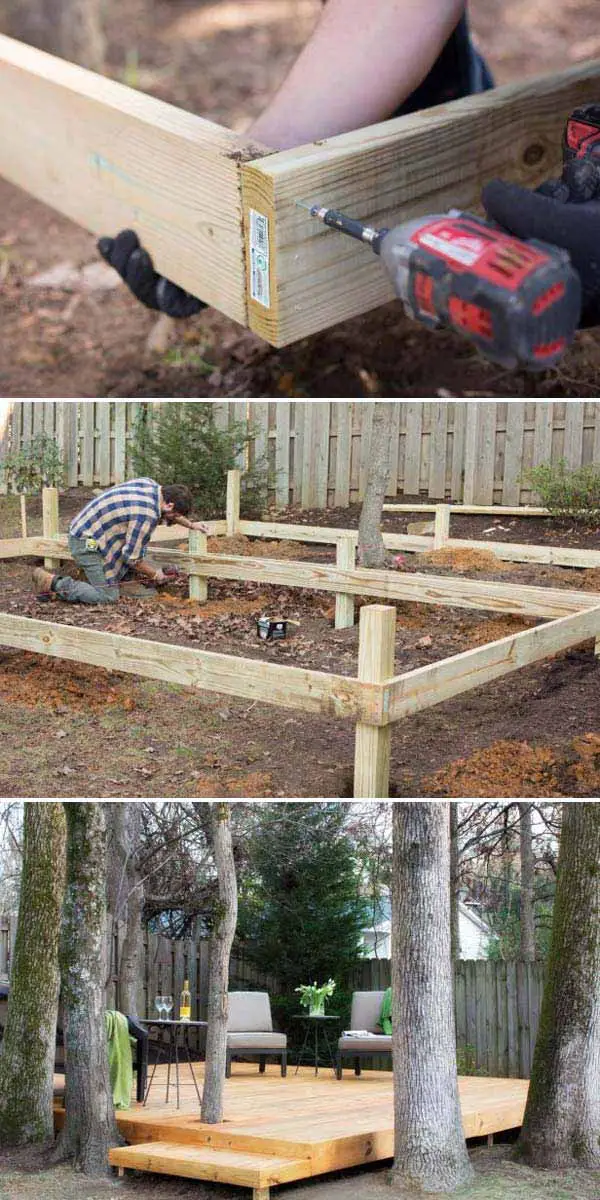
Kid’s Pallet Wood Deck W/ PLANTER AND SANDBOX
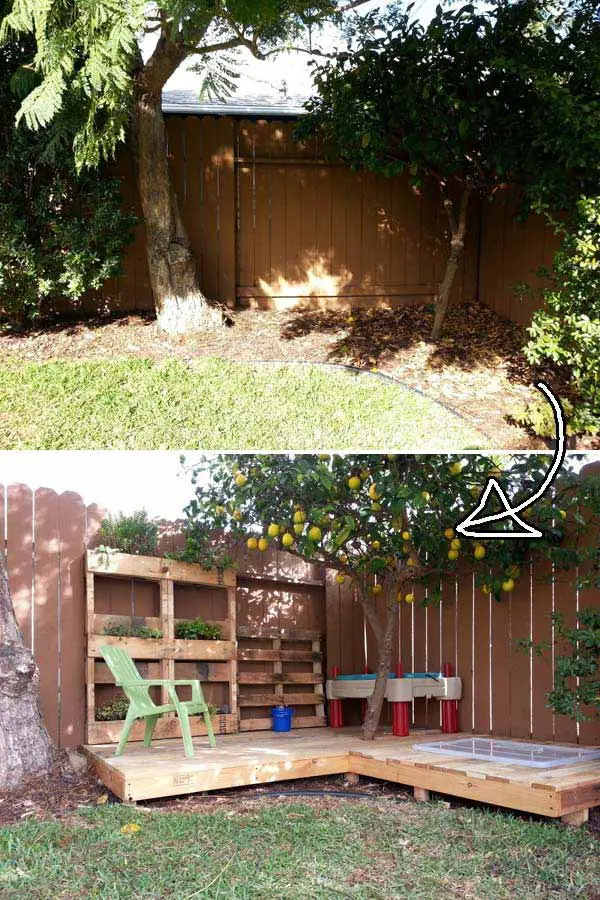
Floating deck before stain
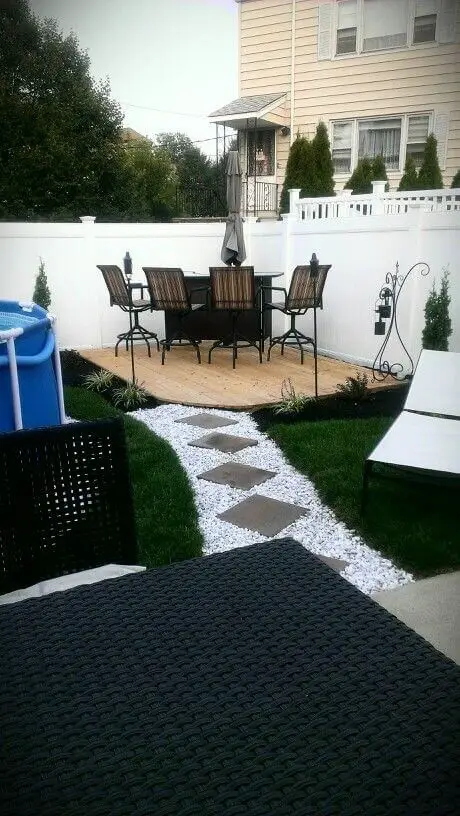
A small floating deck
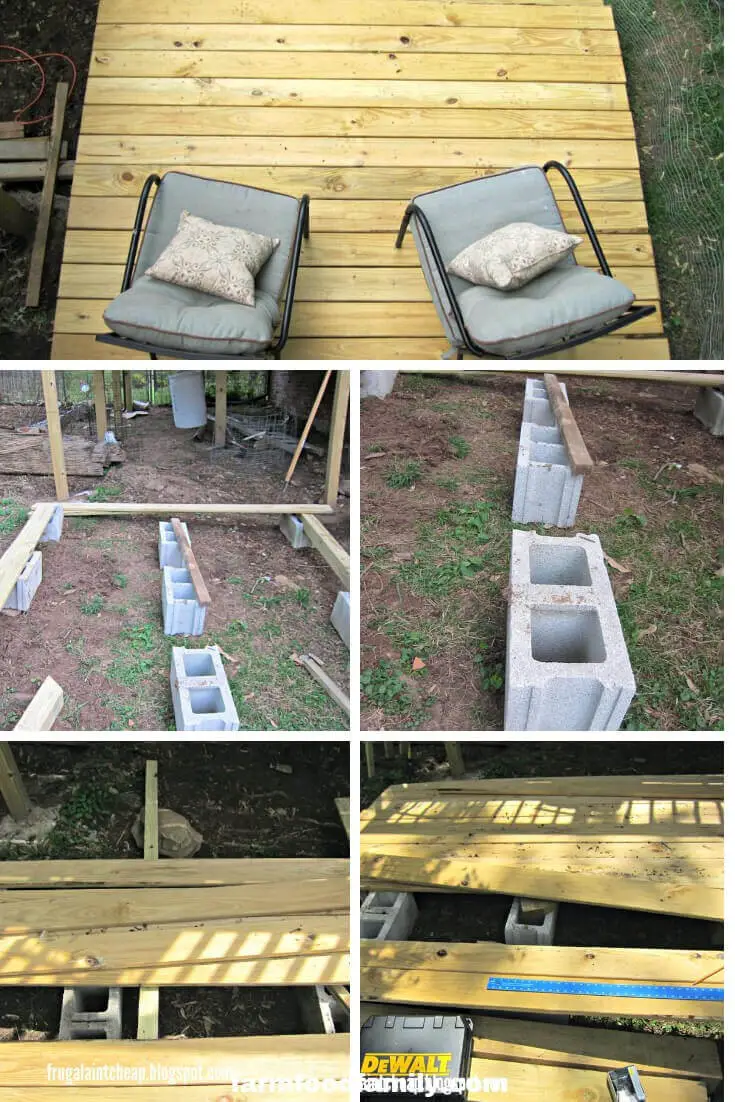
DIY Floating Deck in 48 hours for less than $500
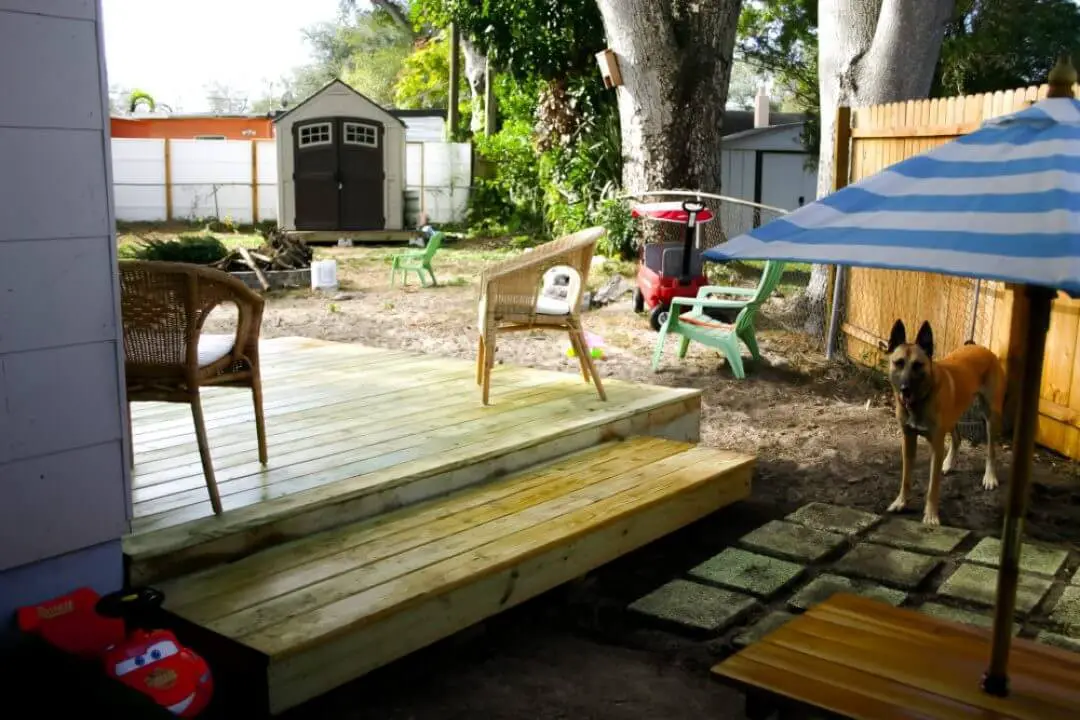
Small garden floating deck
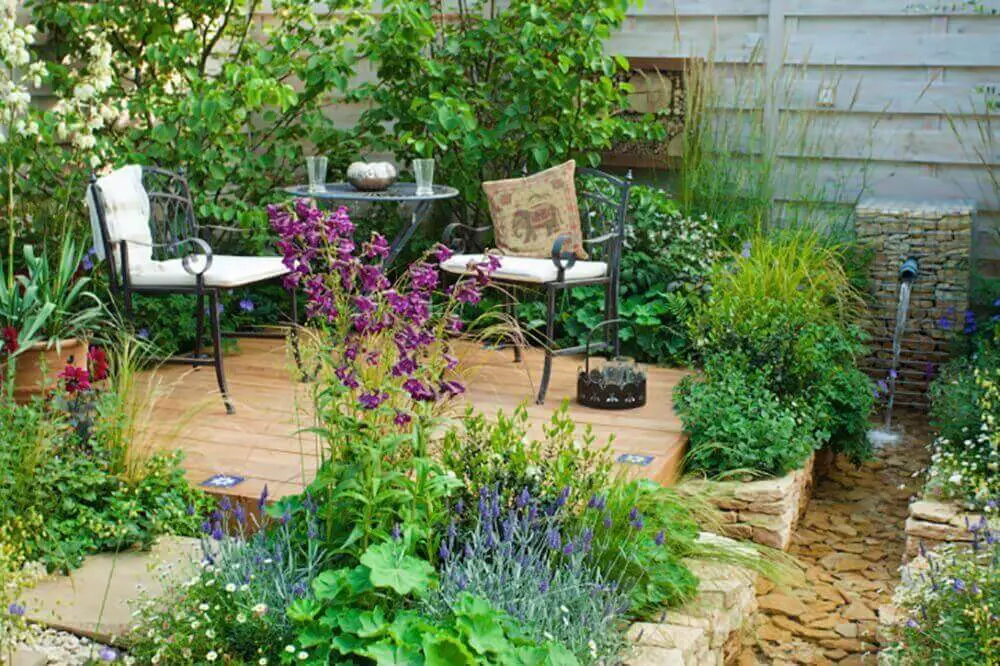
Wood Minimalist Floating Deck
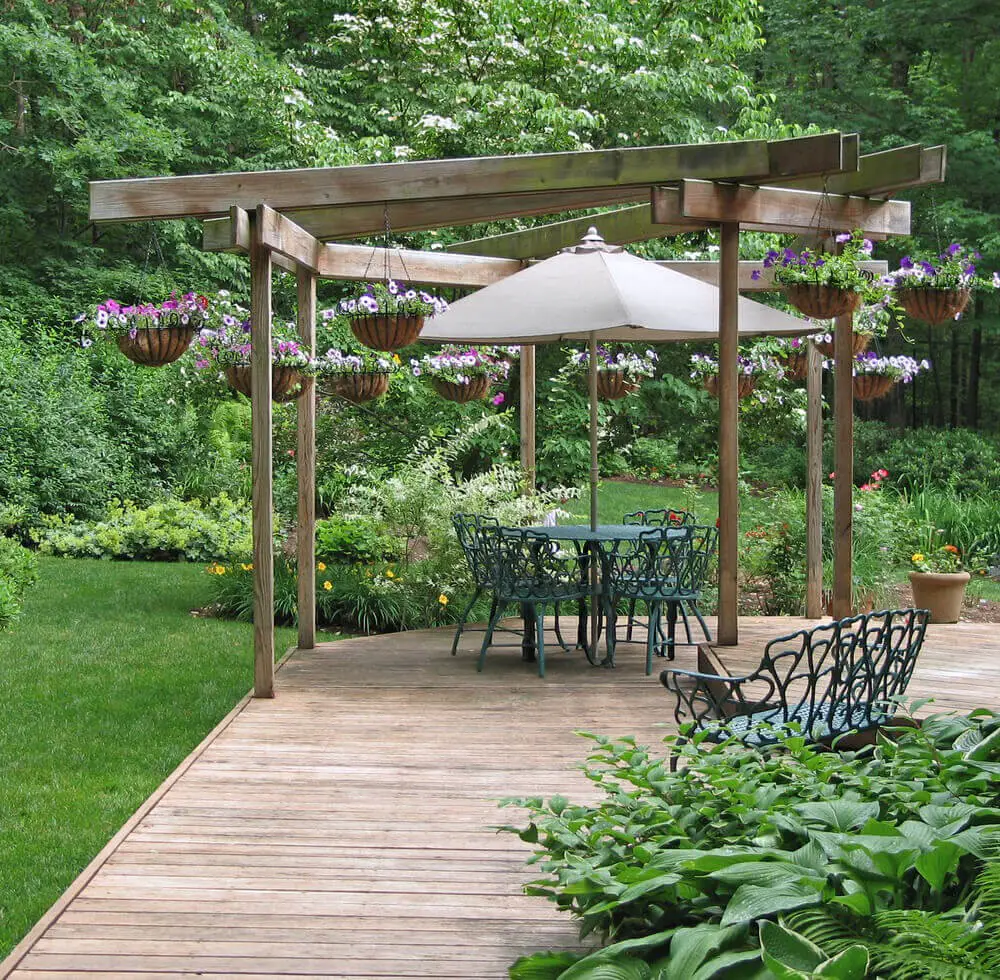
V-Shaped Floating Deck
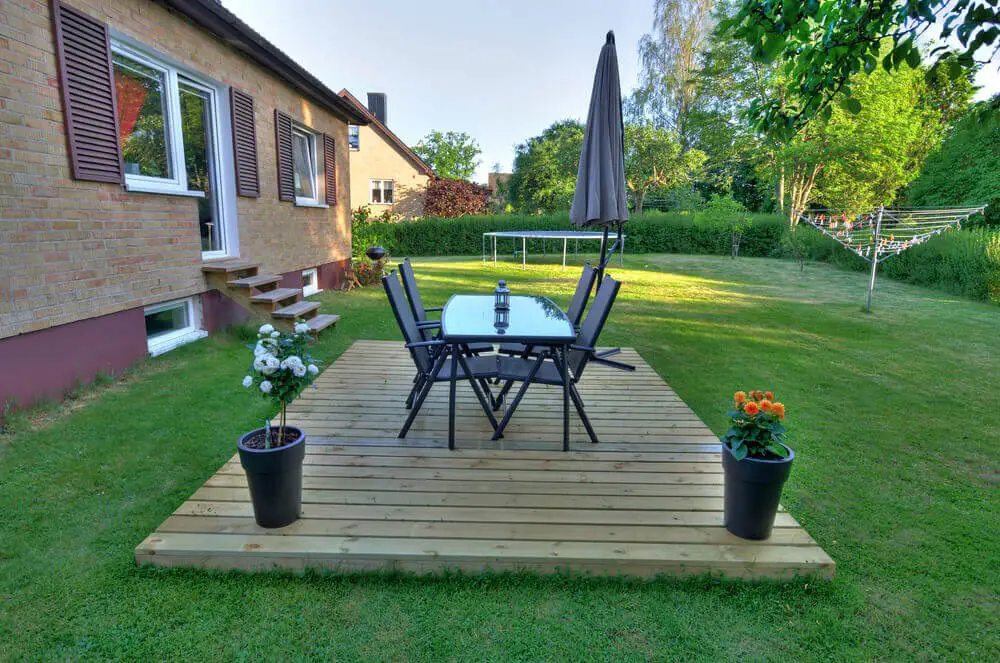
a Cool Floating Deck
Floating deck with pergola
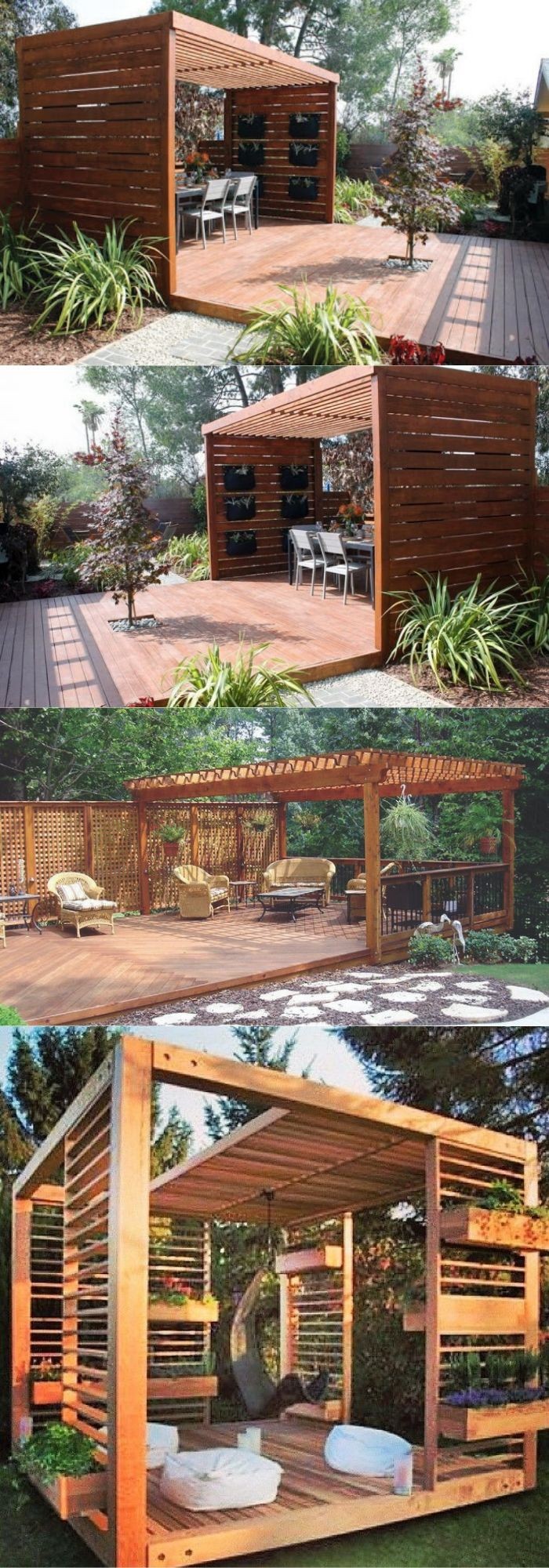
Deck with curved wood roof
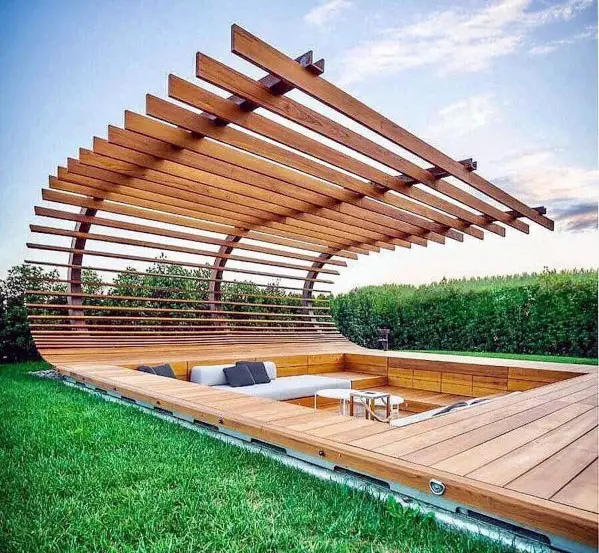
Floating deck with privacy
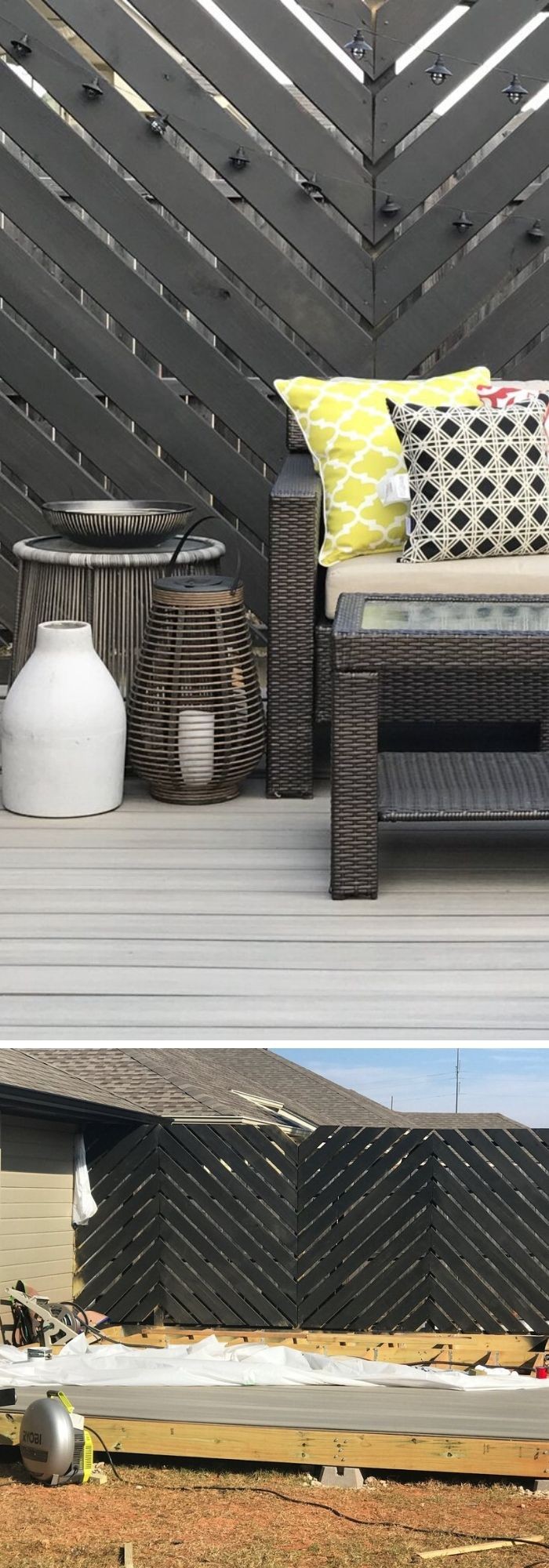
Garden floating deck
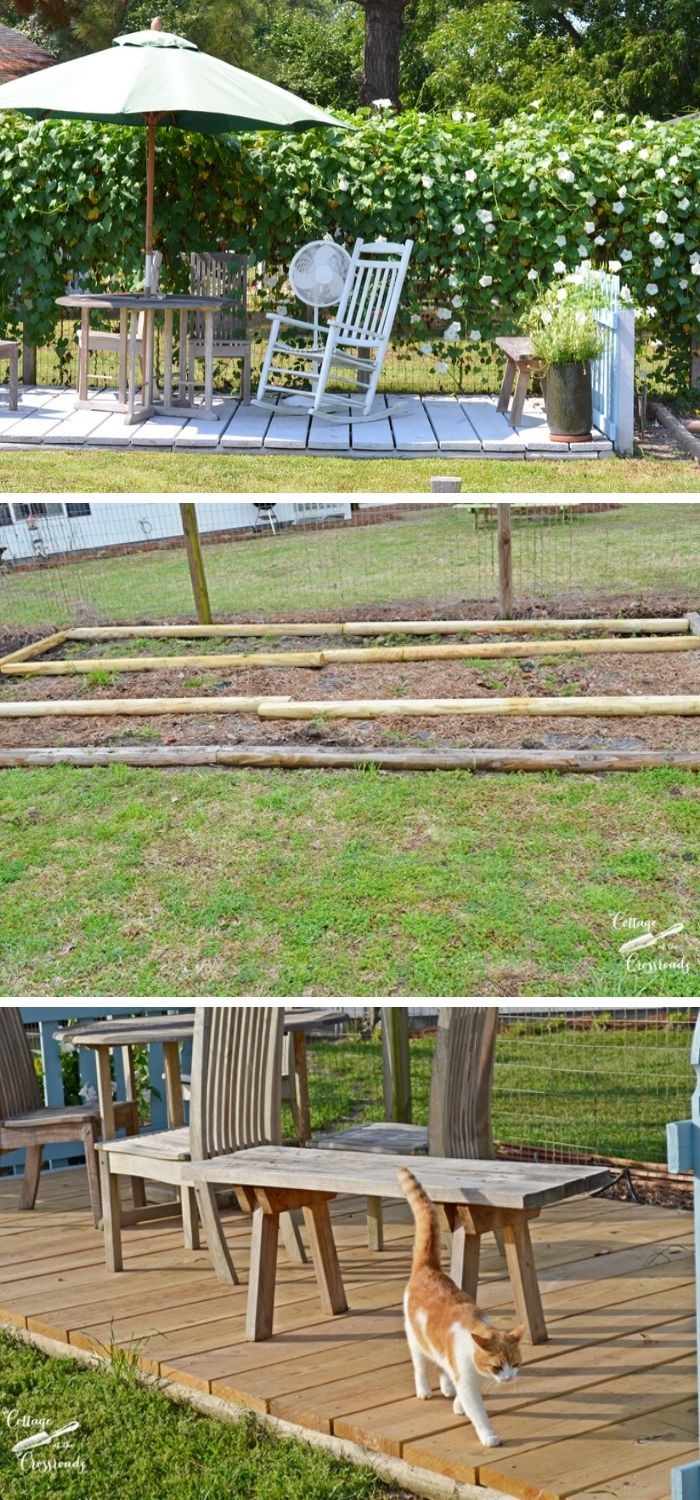
Small and white floating deck
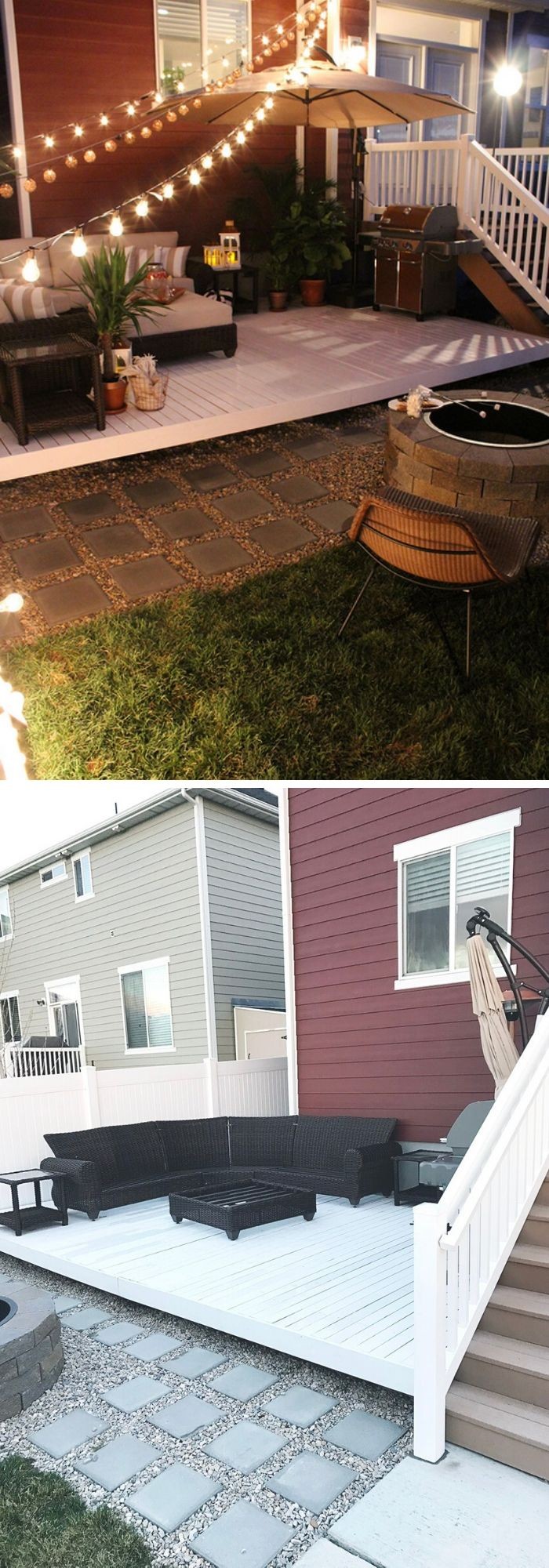
Sloped backyard floating deck
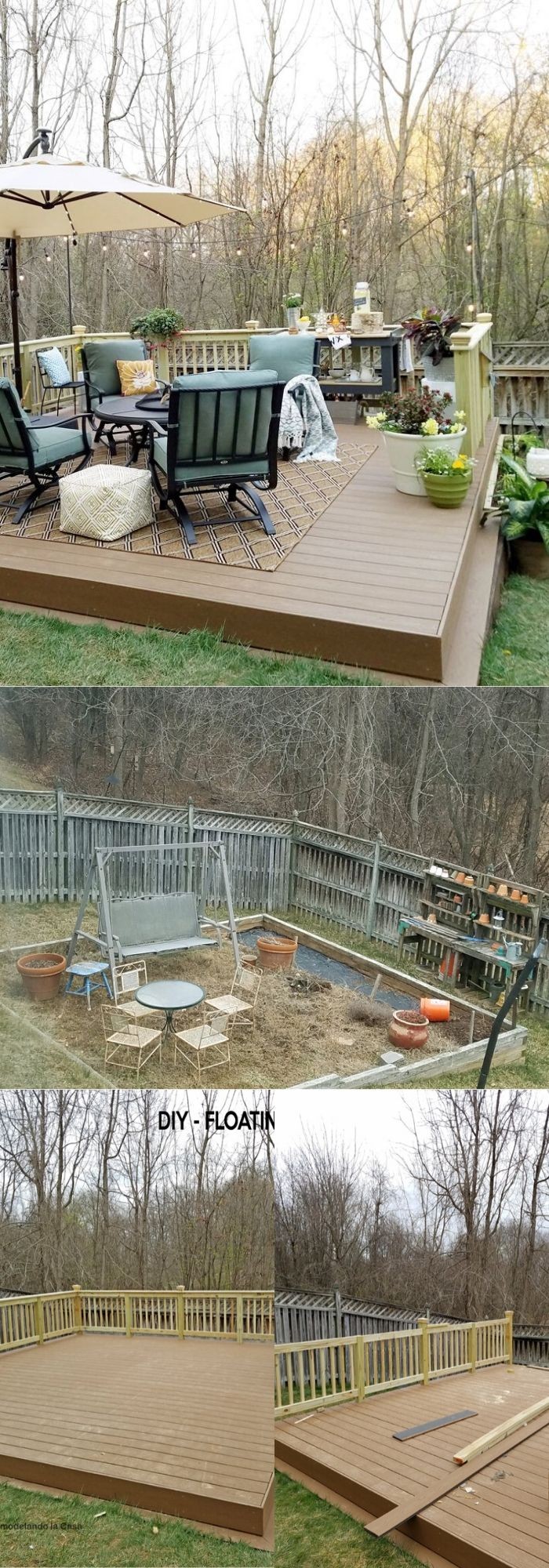
Railroad tie and concrete block floating deck

Floating deck cost
When it comes to budgeting for a floating deck, the cost can vary significantly depending on several factors. On average, the price per square foot typically falls between $20 and $60. Considering these estimates, a 12-by-12-foot floating deck would likely fall within the range of $3,000 to $10,000. This total includes both material costs as well as labor expenses.
How to build a floating deck
For those looking to take on a weekend project that will yield a lasting impact, building a floating deck DIY is an excellent choice. To guide you through this process, we’ll outline the essential steps below.
The journey begins with preparing the deck area by clearing it of debris, grass, pebbles, and other organic matter. Ensure the surface is flat, level, and compacted. Additionally, consider laying down landscape fabric at this stage to prevent weed regrowth in the future.
Next, create a support frame using concrete blocks. This cost-effective solution involves arranging the blocks in a rectangular pattern with 12-ft gaps on the long sides and 10-ft gaps on the short sides. Once the foundation is established, move on to building the outer frame, which will serve as the base for your deck’s planks.
Drill holes and secure the planks with screws before positioning the outer frame and resting it on the concrete blocks.
Verify that the blocks are in precise contact with the wood frame, making any necessary adjustments to ensure stability. After the structure is stable, install the remaining joists and complete the outer frame.
Finally, install the deck boards one by one along the frame, followed by a coat of paint or stain for the finishing touches. Arrange your lounge chairs and other accent pieces on the newly constructed floating deck, ready to enjoy the fruits of your labor.
FAQs
Do you need a permit for a floating deck?
Fortunately, floating decks don’t share the same structural concerns as attached decks. Unencumbered by ties to the home’s foundation, these outdoor spaces aren’t deemed part of the original property structure or an extension of the living area. However, it’s still crucial to verify with your housing association, if applicable, to ensure compliance with local regulations.
Can you put a hot tub on a floating deck?
While decks at a 2ft elevation can typically accommodate a 100-lbs hot tub, higher elevations require additional support to ensure safety and stability. To safely install a hot tub on a floating deck with an elevated foundation, you’ll need to reinforce the structure by adding low concrete posts around each side of the deck. This crucial step ensures your hot tub remains securely in place, even when water is added or individuals are using it.
How long does a floating deck last?
When it comes to the lifespan of floating decks versus traditional decks, the truth is that they can share a similar longevity. With proper upkeep, a well-maintained floating deck can potentially last between 10-15 years. However, just like traditional decks, floating decks do require periodic maintenance to preserve their appearance and structural integrity. Specifically, every two years, they’ll need to be re-stained to prevent weathering and damage.
For those seeking even lower maintenance options, alternative materials such as concrete or composite composites may be a more appealing choice.
How much weight can a floating deck hold?
The load-bearing capacity of a floating deck depends on the material used. Typically, it can support a minimum of 50 pounds, with the weight of the deck itself accounting for about 10 pounds. The remaining 40 pounds are attributed to the combined weight of furniture, people, and other items that may be placed on the deck.
How high can a floating deck be?
When designing a floating deck, it’s essential to keep in mind that excess heights can lead to structural issues. A general guideline is to cap your floating deck at an elevation of 8 feet or less, with an ideal height range of 2-3 feet for maximum stability and aesthetics. If you do decide to exceed this threshold, be prepared to implement additional support measures such as bracing underneath the deck and from post to beam to ensure a secure and safe structure.
Conclusion
In conclusion, opting for a floating deck is the way to go when traditional decks are out of reach financially or you want to create a unique lounging space for loved ones. One of the most significant advantages is that it doesn’t require a building permit, making the process more streamlined. Additionally, constructing a floating deck is often less labor-intensive and can result in significant cost savings.
The design possibilities are also virtually endless, allowing you to truly make your mark on the project. With the information covered so far, you should be well on your way to solidifying your floating deck plan. If DIY isn’t your forte or you’re unsure about building from scratch, consider enlisting the help of a professional to guide you through the process.

